Salesforce Introduces Advanced Edition at Dreamforce 2024
At the Marketing Keynote at Dreamforce 2024, Salesforce announced an exciting expansion to its suite of marketing solutions — the Marketing Cloud Advanced Edition, which builds upon the existing Marketing Cloud Growth Edition and offers even more powerful tools to help small and medium-sized businesses (SMBs) engage their customers in a more personalized and efficient way.
With customer expectations rapidly evolving, Salesforce recognizes the need for marketing platforms that deliver consistent engagement across channels, from marketing to sales, service, and commerce. The Advanced Edition, therefore, comes at a critical time for SMBs striving to innovate, leverage new technologies, and scale their marketing efforts effectively.
In this article, we will explore what this announcement means for businesses and provide a detailed comparison between the Growth and Advanced Editions. The DESelect Marketing Optimization Platform complements these offerings to maximize their potential.

Recap of Salesforce Marketing Cloud Growth Edition
The Salesforce Marketing Cloud Growth Edition was initially introduced to help small and medium-sized businesses (SMBs), particularly B2B organizations, scale their marketing efforts with an integrated platform that combines data management, AI capabilities, and marketing automation. Here’s a comprehensive look at its core features:
AI-Powered Campaigns
Automate and optimize email marketing campaigns using AI insights to better target and engage audiences. Einstein AI enables predictive analytics to enhance campaign effectiveness, ensuring content reaches the right people at the right time.
AI-Powered Segmentation
Leverage machine learning to segment customers based on behavior, demographics, and preferences. This feature allows marketers to create highly targeted audiences, enhancing the relevance and personalization of marketing messages.
Email Marketing
Utilize robust tools for creating, sending, and analyzing email campaigns. The platform includes customizable templates, drag-and-drop builders, and comprehensive analytics to track performance metrics such as open rates, click-through rates, and conversions.
Forms and Landing Pages
Easily build responsive forms and landing pages to capture leads, drive engagement, and convert visitors into customers. The Growth Edition provides templates and drag-and-drop builders to streamline this process.
Lead Scoring
Identify and prioritize potential leads based on their behavior and interaction with marketing content. This scoring helps sales teams focus on the most promising prospects, improving conversion rates.
Multi-Channel Journeys
Design and automate customer journeys across multiple channels, including email, social media, and SMS. This capability ensures consistent engagement and messaging throughout the customer lifecycle.
Web Tracking and Analytics
Gain insights into customer behavior on your website. Understand which pages are driving the most traffic and engagement, and use this data to optimize your content and marketing strategies.
Consent Management
Manage customer consent and preferences to ensure compliance with data privacy regulations like GDPR. This feature provides tools for capturing and storing consent, along with options for customers to manage their communication preferences.
Send Time Optimization
Use AI to determine the best times to send emails to maximize engagement rates. This tool analyzes past engagement data to identify optimal send times for different segments of your audience.
Cross-Object Merge Fields
Easily merge data from different Salesforce objects (such as Contacts, Accounts, or Opportunities) into a single view to personalize communications.
Dynamic Content
Customize email content dynamically based on user behavior, preferences, or attributes. This ensures that each customer receives relevant and personalized messages.
Campaign Attribution Reporting
Track the performance and ROI of your marketing campaigns, linking them directly to business outcomes such as revenue growth or lead generation.
SMS (Add-On)
Engage customers via SMS as an additional communication channel, particularly useful for time-sensitive offers or updates.
For a more in-depth exploration of the Marketing Cloud Growth Edition, check out this article, which provides a foundational overview, including setup, use cases, and benefits for B2B SMBs.

Key Features of Marketing Cloud Advanced Edition
The Marketing Cloud Advanced Edition builds upon the robust capabilities of the Growth Edition, expanding its feature set to meet the needs of both B2B and B2C SMBs. It includes all the functionality of the Growth Edition plus several new enhancements that make it a more powerful tool for marketers aiming to drive engagement, improve personalization, and optimize marketing performance.
Path Experimentation
The Advanced Edition introduces path experimentation, allowing marketers to test up to 10 different customer journey variations with varied channels, messaging copy, and cadence. This feature supports unbiased testing across multiple channels (e.g., email vs. SMS) to determine which strategies are most effective. Automatic randomization ensures unbiased results, and campaign effectiveness is maximized by tailoring paths based on performance.

AI-Powered Engagement Tools
- Einstein Engagement Frequency: This feature leverages AI to suggest the optimal frequency for messaging, preventing over-saturation or under-communication. It provides real-time insights into message effectiveness and dynamically adjusts send frequencies to enhance engagement.
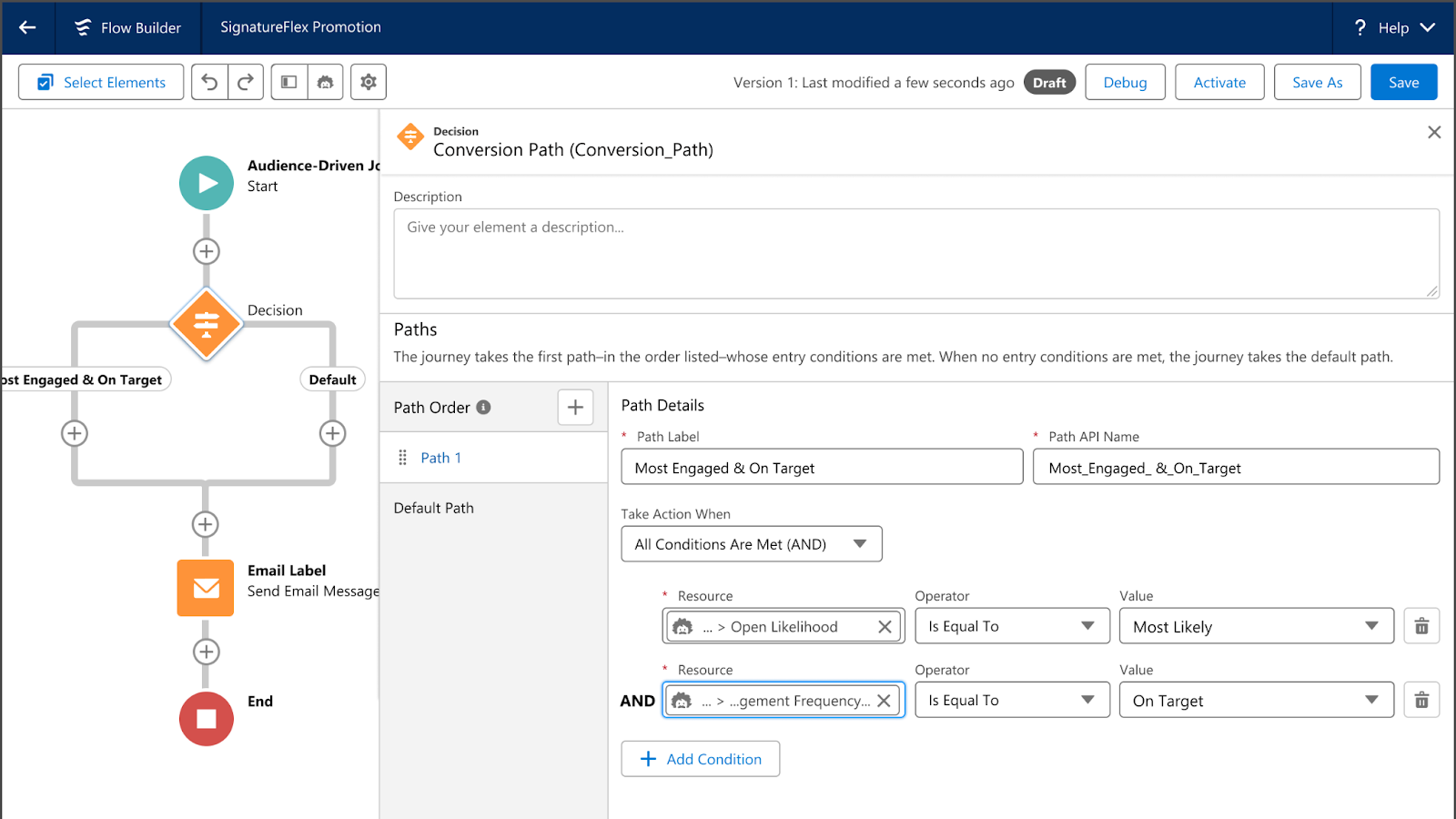
- Einstein Engagement Scoring: This capability uses AI to automate lead scoring by evaluating engagement levels, helping marketers identify and prioritize the most promising leads. Every individual is scored on their likelihood to open, click and stay subscribed to email and to convert, enabling marketers to create audiences, segments, split paths in Flow, and personalize content.

Conversational SMS*
Integrates SMS with marketing and service functions to turn one-way promotions into a connected conversation experience. Marketing messages can be handed off to human agents or bots in real-time based on the context, ensuring a consistent and responsive interaction.

Opportunity Influence
This new feature, available in both Growth and Advanced Editions, helps marketers understand the impact of their campaigns on sales by providing first- and last-touch attribution. It links marketing engagement data to sales opportunities, highlighting the contribution of marketing to the overall revenue.
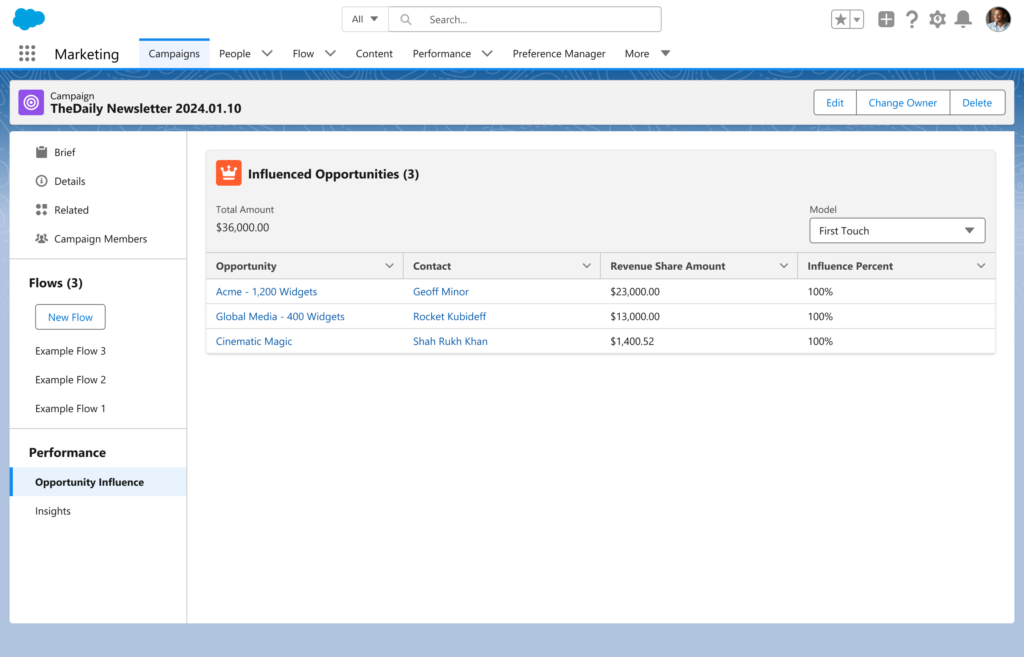
Dynamic Content and AI-Enhanced Campaign Building
The Growth and Advanced Editions streamline the creation of dynamic content directly within the campaign builder, reducing workflow friction and speeding up the content creation process.
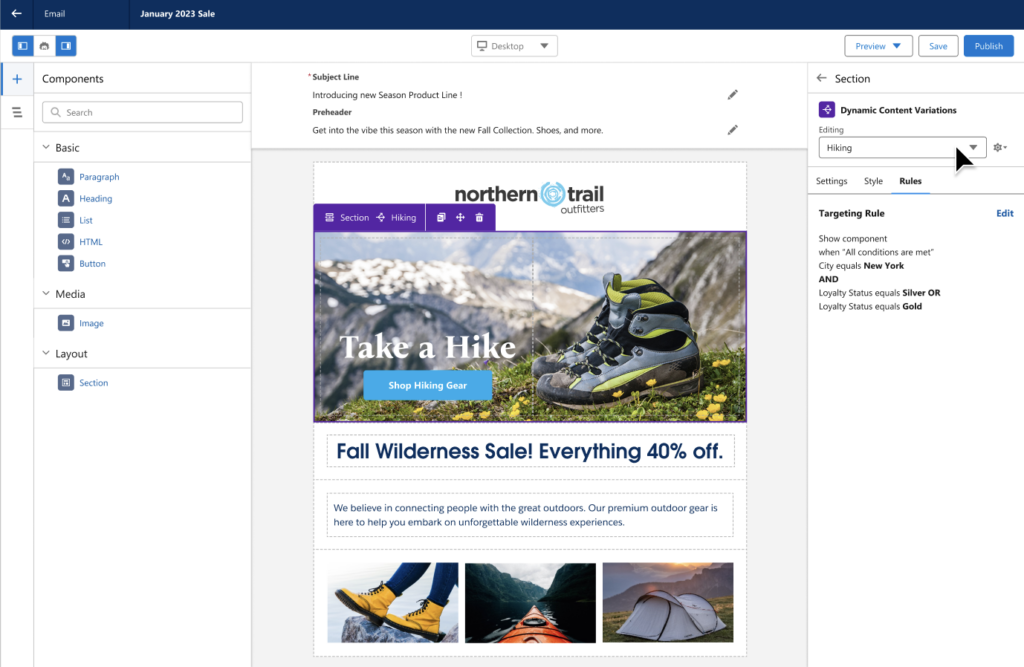
Comparison Table: Growth Edition vs. Advanced Edition
Feature | Growth Edition | Advanced Edition |
|---|---|---|
AI-Powered Campaigns | ✓ | ✓ |
AI-Powered Segments | ✓ | ✓ |
Path Experimentation | — | ✓ |
AI-Powered Engagement Frequency | — | ✓ |
AI-Powered Engagement Scoring | — | ✓ |
Conversational SMS | — | Add-on |
Opportunity Influence | ✓ | ✓ |
Dynamic Content | ✓ | ✓ |
How DESelect Optimizes Advanced Edition
The Advanced Edition’s new features, particularly Einstein Engagement Frequency, align perfectly with the capabilities of DESelect Engage. By integrating with Salesforce Flow, DESelect Engage can further optimize send frequencies, ensuring that customers receive the right messages at the right times. To get in touch directly with a DESelect Salesforce Marketing Cloud Expert, book a meeting here.
Conclusion
Salesforce’s strategic direction is clear: empowering SMBs with more robust, integrated, and AI-driven marketing solutions. The Marketing Cloud Advanced Edition not only enhances the capabilities of the original Growth Edition but also opens new avenues for B2B and B2C companies to innovate and scale their marketing efforts effectively. As Salesforce continues to build on its powerful platform, DESelect is excited to support and enhance this journey with our specialized solutions. The future of marketing looks brighter than ever, and we’re thrilled to be a part of it!
Before implementing any new marketing strategy, it’s essential to ensure it aligns with your goals and needs. Understanding when you may need a frequency capping solution for Salesforce Marketing Cloud can make a significant impact on whether your campaigns resonate with consumers or end up in the junk folder.
This comprehensive checklist will help you evaluate if it’s time to consider implementing frequency capping into your marketing strategy.
Checklist 1: Assess Your Current Marketing Campaigns
- Are you experiencing complaints from subscribers about receiving too many emails or messages?
- Have you noticed a decrease in engagement metrics, such as open rates or click-through rates?
- Do you have poor visibility into subscriber saturation across your multichannel campaigns?
- Do you have poor visibility into the frequency of communications sent out across multiple Marketing Cloud business units?
- Are there any specific campaigns where you suspect over-messaging may be occurring?
- Are there clearly defined rules in place for how many messages a subscriber type can receive in a certain period?
- Do you have a system for prioritizing the importance of campaigns against each other?

If you checked two or more boxes, keep reading, because there’s likely a major disconnect between what messages you’re sending out and how subscribers perceive them.
Checklist 2: Understand Your Audience
- Have you defined your audience segments clearly, and are you creating content accordingly?
- Are you creating personalized messages for subscribers of your segments?
- Are you creating audience segments based on behavioral data?
- Are you allowing subscriber preferences based on frequency and content type?
- Do you have a clear understanding of the desired frequency for different segments of your audience?

If you checked two or fewer boxes, you’re likely too reliant on mass communication. This strategy not only misses opportunities to communicate with subscribers on a one-to-one level, you also run the risk of disengaging audiences with overly generic messages.
Checklist 3: Evaluate Your Data
- Is your subscriber data clean, up-to-date, and accurate?
- Are you honoring unsubscribe requests?
- Do you have historical data on subscriber engagement and response rates?
- Are you using Marketing Cloud's tracking and reporting features effectively to monitor campaign performance?

Each option in this section is crucial to database health and long-term marketing performance. Missing a check for any of these means you need to make immediate changes.
Checklist 4: Explore the Benefits of Frequency Capping
- Have you researched the benefits of implementing a frequency capping tool/solution in SFMC?
- Are you aware of how frequency capping can improve subscriber satisfaction and engagement?
- Do you understand how it can help prevent subscriber fatigue and reduce unsubscribes?
- Are you open to exploring third-party frequency capping solutions that integrate seamlessly with Salesforce Marketing Cloud?
- Have you evaluated the compatibility of such solutions with your existing setup?
- Do you know how long it will take to implement the solution?

If you checked four or fewer, you’ll need to research more into what saturation control is and how it improves customer experiences. Get started here.
Checklist 5: Analyze Costs and ROI
- Have you calculated the potential return on investment (ROI) of implementing a frequency capping solution?
- Have you compared the costs of implementing a solution with the potential savings from improved campaign performance?
- Have you consulted with Salesforce Marketing Cloud experts or partners for guidance on frequency capping?
- Have you reached out to other Salesforce Marketing Cloud users to learn from their experiences?
- Have you looked into a plug-and-play solution like DESelect Engage?
Next Steps
By completing this checklist, you should have a clearer picture of whether implementing a frequency capping solution is the right move for your marketing strategy. If you find yourself missing multiple boxes in the checklist, it may be time to explore frequency capping options to optimize your marketing efforts.
DESelect Engage is specifically built to help marketing teams solve saturation control, intelligently prioritize communications, and optimize campaigns across teams.
Learn how The Brain Tumour Charity uses Engage to improve customer journeys and put an end to marketing fatigue across their 72,000 contacts. To schedule a meeting with a DESelect expert, please fill out this form.

Audience Engagement Scoring 101: Finding Your Best Subscribers DESelect | Best Salesforce Marketing Cloud Solutions
63% of marketers segment and personalize customers’ messages based on their behavior. But what does that really mean?
It is always crucial for companies to establish what kind of relationship they possess with each subscriber, no matter how they operate. You should know exactly which contacts resonate with your content, need more nurturing, or should be completely abandoned.
Luckily, there is a practical and efficient method to determine each subscribers’ engagement level that will empower your marketing team with precious insight for future campaigns.
What is Audience Engagement Scoring?
Engagement scoring is a method used to discover and sort customer engagement into tiers used to power future campaigns. At the end of this process, each customer will have a score indicating the individual level of interaction with your content, giving marketers a clear criterion to segment their audiences. With this knowledge, your team can engage with your audience on future behavior-based campaigns using the appropriate amount of content.
This method applies to both B2C and B2B audiences. For example, retail companies benefit from audience scoring by sorting their customers for proper retargeting. B2B companies benefit from it by driving alignment between sales and marketing and giving insights into the best moments to reach out to the right audience. Another typical model for evaluating the value of your subscribers is RFM (Recency, Frequency, Monetary Value) analysis.
How does it work?
Engagement scores depict your customers’ behavior through numeric values and that change over time based on subscriber interactions (e.g. clicks, bounces) or how marketers influence them (e.g., sending more personalized communications).
On the other hand, each customer is characterized by a grade. This grade shows how interested you are in your customers, and is usually a non-numeric label (i.e., a grade from A – F). Marketers typically rely on demographic attributes (e.g. industry, city, job title, company name) to generate customer grades.
In order to calculate the full engagement score, use both behavioral data and customer attributes. The process consists of the following steps.
- Finding the criteria/attributes that have either a positive or negative impact on the customer’s engagement.
- Defining how important each criterion/attribute is and assigning positive or negative points that reflect the impact of each. For example, a customer making routine purchases will have more impact on the final score than signing up for a newsletter.
- Summing up the points each customer collects based on their actions/attributes into an overall engagement score.
- Based on the engagement score for each subscriber, placing each into corresponding tiers and devising a marketing plan for next steps.
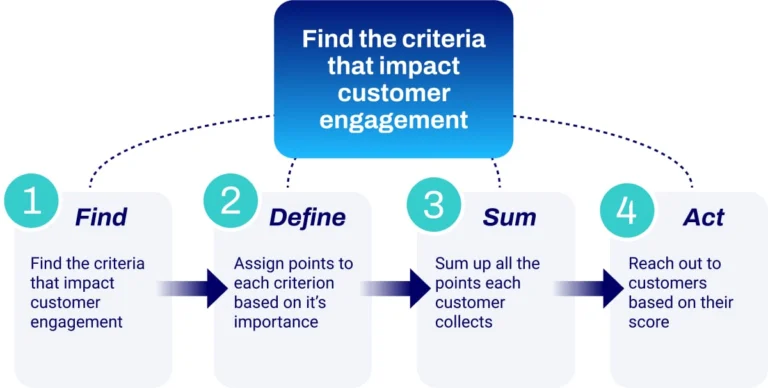
Why use an Audience Engagement Scoring Model?
As businesses grow, your marketers are bound to receive more and more unqualified leads. Scoring allows for better tracking of customers, ranking them based on how qualified they are to make a purchase. By knowing how high each customer scores, marketers are able to allocate more resources to more qualified customers and minimize the time spent chasing dead ends.
Additionally, efficiently engaging with the most passionate customers has a positive impact on campaign metrics, increasing conversions, close rates, and response times, with more targeted campaigns, for example.
Things to keep in mind before creating your Model
To create the most effective model, you need to collect as many customer insights as possible to understand the driving factors that lead them to take action.
Sync with your sales representatives to best understand what factors affect the buying process, either positively or negatively, or conduct customer research to find what they consider important. Pro tip: do not neglect old customers’ buying behaviors – analytics give insight into factors that have historically driven purchases.
While creating scores, it is also important to define negative criteria. You should not only try to find factors that positively influence your customers’ chances of buying your products but also the ones that seem to discourage them. It is very important to filter out people who are not interested in buying your products. For instance, someone might have subscribed when visiting your website, but then only visited the job applications page. Include such criteria in your model with a negative score.
Building an Engagement Scoring Model in SFMC
Step 1: Make sure data is available in SFMC
Let’s assume you already have the required data to build your model. Before you start, make sure to bring all necessary data inside your Salesforce Marketing Cloud instance – whether it originates in Sales Cloud or an external CRM, CloudPages form submissions, an internal Marketing Cloud platform such as Contact Builder, or imported via FTP.
For this article, let’s use a hypothetical physical retailer as an example. To build our model we will use information about our customers’ location, orders history, and reaction to past emails. We store this data in Data Extensions and Data Views. To build our engagement model we are going to use one Data Extension that contains customer information and one that contains order information. Have a look at the two Data Extensions below.
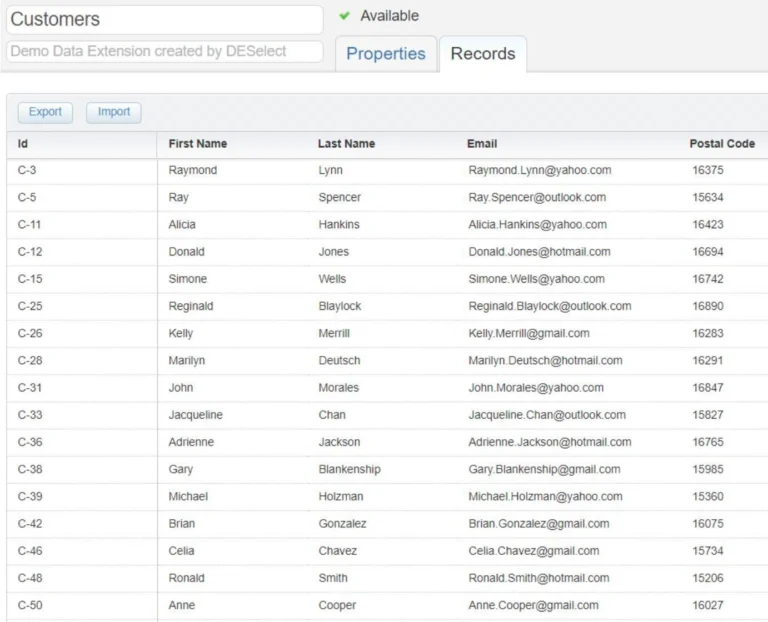

Step 2: Define your model
After compiling the data, you need to choose the factors that make your customers more qualified. For the example we are presenting here and based on the information we have for our customers, we ended up with the following criteria and scores.
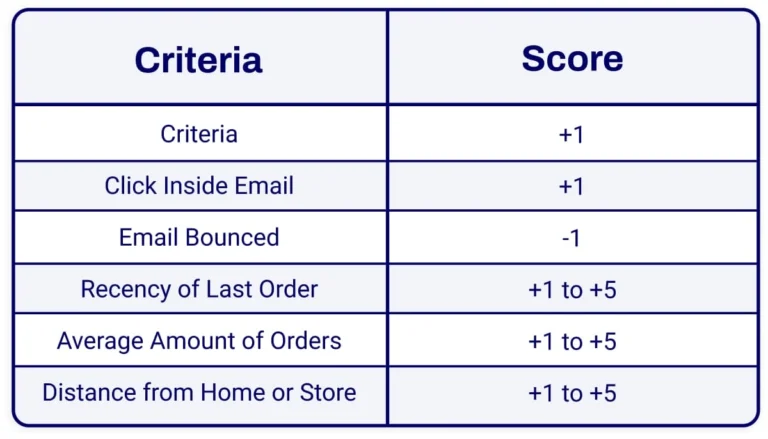
Notice how many factors have wide variations. Focusing on one, recency of last order, we find there is a scale from 1-5 correlating to how long ago a customer made their most recent purchase. Customers with orders in, say, the previous month are given a high score of 5, while customers at the opposite end of the spectrum, say, one purchase 11 months ago, are given a 1. Customers whose last order was over a year ago may be removed from this scoring system entirely to reflect how cold of a lead they are.
Ranged scoring provides greater nuance, as opposed to fixed scoring. For criteria involving frequency, having a given value often provides similar insight into customer intent. In this example, clicking an email adds one point to a customer’s score, so multiple clicks across multiple emails enhances their overall rank.
Step 3: Implement your model using DESelect
With your score criteria defined, it is time to implement the engagement scoring model using DESelect. The image below indicates the different selections created for the example, and the scores that will be calculated individually.

Here is a step-by-step breakdown of the process for our example.
The first thing you need to do is create a selection that will calculate the points each customer collects for each criterion and store it in a Data Extension.
1. Open DESelect inside your Marketing Cloud instance
2. Click on New Selection to create a new selection.
3. Provide the name Customer Engagement Scores (or similar) for your selection.
4. Choose your Selected Data Extensions, in this case Data Extensions Customers and Orders.
5. Create a relationship between them on Id and CustomerId fields, and keep all records from Customers Data Extension.

6. Move on to the Target Definition screen and click on Create Data Extension.
7. Provide the name Customer Engagement Scores and click Save.
8. Add the Id field of the Customers Data Extension to Target Data Extension fields.

Opens – Clicks – Bounces Score
We will now calculate the points for opens, clicks, and bounces. At this point we are not yet interested in positive and negative scores, therefore we will calculate these three fields in exactly the same way. This will also help evaluate overall email deliverability and engagement by counting how many times a customer has opened an email, clicked inside an email, or bounced out of an email.
This information can be found inside Data Views, which are tables generated by SFMC. Through Data Views you’ll find data such as subscribers and Marketing Cloud event tracking (e.g., email/sms sends, email opens, link clicks).
1. Click on Add new value inside the Custom Values section.
2. Set name to Opens Score, choose Aggregation as type and click on Next.
3. Choose Count as the aggregation function.
4. Choose SubscriberKey of _Open Data View as the field.
5. Match Customers’ Email field with _Open ’s SubscriberKey field. The Custom Value looks like this:
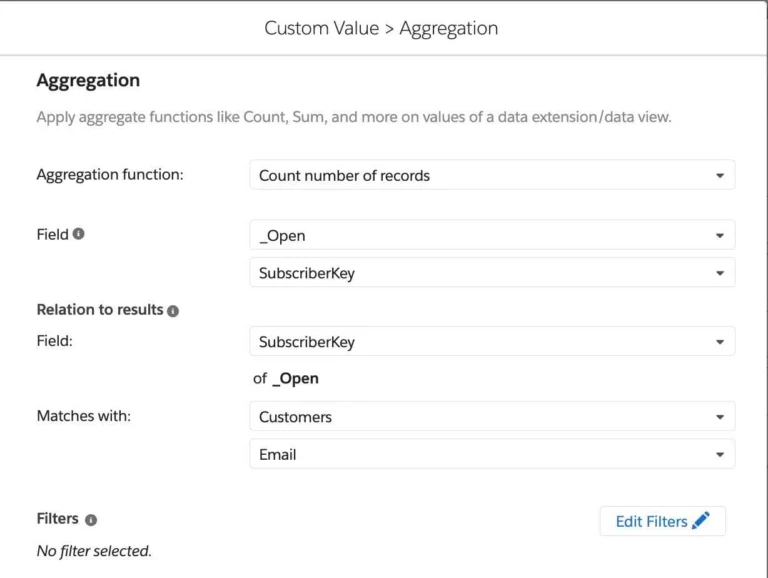
6. Click on Save.
7. Repeat steps 1 – 6 for _Click and _Bounce and name them Clicks Score and Bounces Score respectively.
8. Add all the created values to the Target DE’s fields.
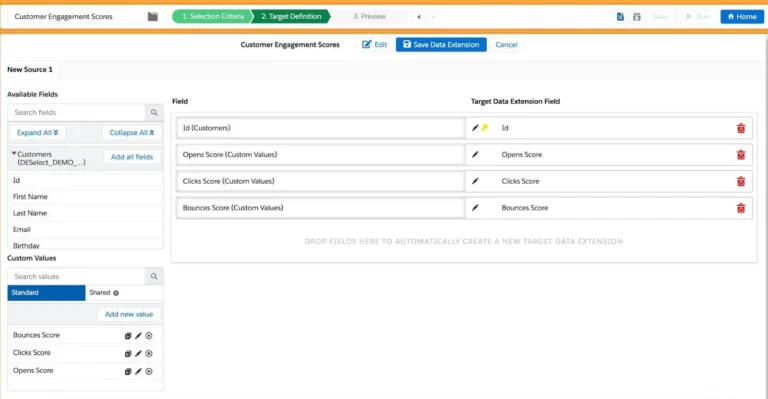
Orders Score
Next, we will assign points to customers based on when they placed an order. Based on our data we defined the following rules:
- 1 point, for orders in the past year.
- 2 points, for orders in the past 9 months.
- 3 points, for orders in the past 6 months.
- 4 points for orders in the past 3 months.
- 5 points, for orders in the past month.
To assign the different scores to our customers we will perform the following steps:
1. Click on Add new value inside the Custom Values section.
2. Set name to Orders Score, choose Dynamic Value as type and click on Next.
3. Select Number as field type and click on Add Criteria.
4. Add Order Date from Orders DE to the filters section.
5. Choose Is After Or On as filter type.
6. Select Relative date and set it to 9 months ago.
7. Add Order Date from Orders DE second time to the filters section.
8. Choose Is Before Or On as filter type.
9. Select Relative date and set it to 1 year ago.

10. Set the Then value equal to 1. Our custom value looks like this:
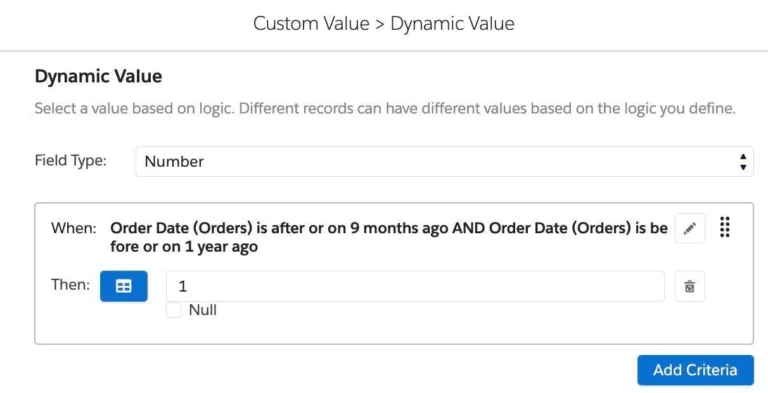
11. Repeat steps 3 – 6, but set the Relative date to match the criteria we defined above, and the then value to the equivalent amount of points.

12. Make sure the Default value is 0 and click on Save.
13. Add the created value to our Target DEs fields.

Distance Score
Moving forward, we want to assign scores based on the distance from customers’ homes to our physical location. We will do that based on their postal codes. We know about the Postal Codes that values:
- Between postal codes 15019-15378 are 5 km away from our store, and will get 5 points.
- Between postal codes 15378-15737 are 10 km away from our store, and will get 4 points.
- Between postal codes 15737-16096 are 15 km away from our store, and will get 3 points.
- Between postal codes 16096-16455 are 20 km away from our store, and will get 2 points.
- Greater than postal code 16455 are more than 20 km away from our store, and will get 1 point.
To assign the different scores to our customers we will perform the following steps.
1. Click on Add new value inside the Custom Values section.
2. Set the name to Distance Score, choose Dynamic Value as type and click on Next.
3. Select Number as field type and click on Add Criteria.
4. Add Zip Code from Orders DE to the filters section.
- Note: Depending on your organization’s data model, this field may be labeled Postal Code and may be nestled under the Customers data extension.
5. Choose Between as the filter type.
6. Set the first input field to 15019 and the second to 15378.

7. Click on Save and set the Then value equal to 5. Our Custom Value looks like this.

8. Repeat steps 3 – 7 for the rest of the postal codes mentioned above, each time decreasing the Then value by 1. In the last group choose Greater Than as filter type.

9. Make sure the Default value is 0 and click on Save.
10. Add the created value to our Target DE’s fields.
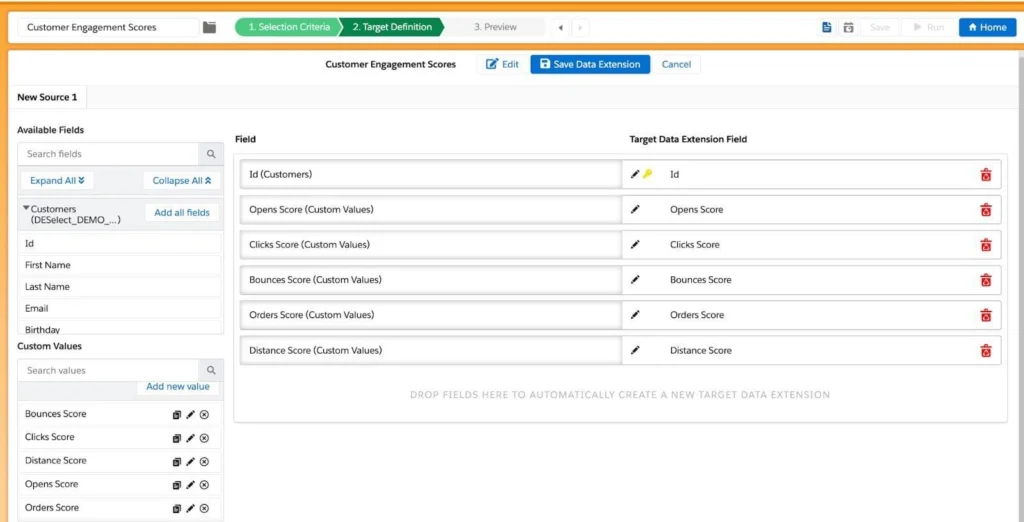
Total Amount Average
Finally we want to assign a different score based on the average of the total dollar amount a customer has spent on purchases in this time period (in our example, one year). We identified the following groups.
- Average between 0 – 25 gets 1 point.
- Average between 25 – 50 gets 2 points.
- Average between 50 – 75 gets 3 points.
- Average between 75 – 100 gets 4 points.
- Average above 100 gets 5 points.
To get the customers of each group we need to first calculate the average of the total amount for each customer.
1. Click on Add new value under the custom values section.
2. Set the name to Total Amount Average, choose Aggregation as type and click on Next.
3. Select Average value for field as the aggregation function.
4. Choose Total Amount from the Orders Data Extension as the field.
5. Match Orders’ CustomerId field with Customers’ Id field. Our Custom Value looks like this.
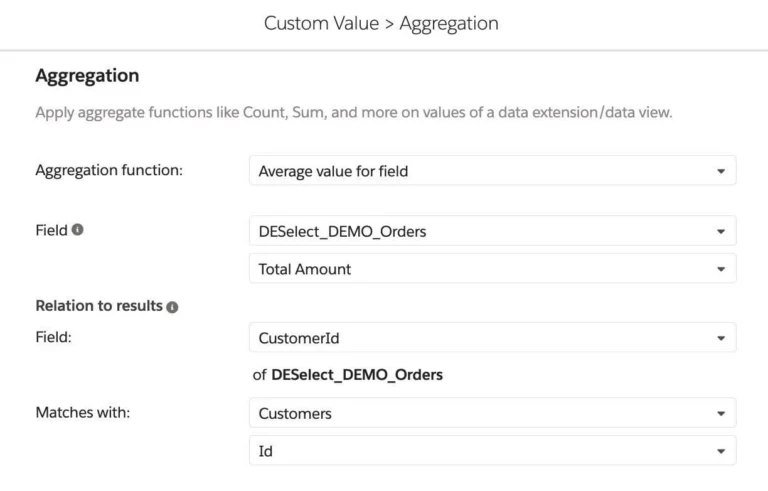
6. Click on Save.
7. Add the created value to our Target DE’s fields.
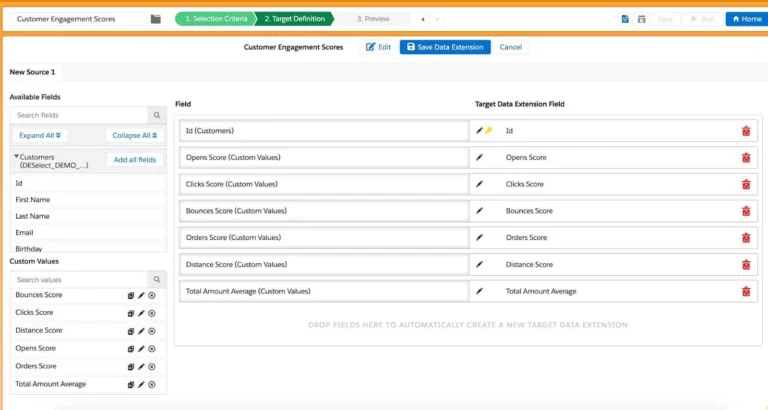
8. Click on the Save Data Extension button.
9. Save your work on the Selection itself. Exit to the DESelect Segment homepage.
10. Click on the Create button.
In order to create the Total Amount Score based on the Total Amount Average we need to create a new selection.
1. Click on Run to populate our Customer Engagement Scores Data Extension with results.
2. Click on the New Selection button.
3. Name it Final Customer Engagement Scores.
4. Add Customer Engagement Scores Data Extension to our Selected Data Extensions.
5. Move on to the Target Definition screen and click on Create Data Extension.
6. Provide the name Final Customer Engagement Scores and click Save.
7. Click on the Add All Fields button.
8. Remove the Total Amount Average field.
Total Amount Score
Now we can calculate the Total Amount Score by implementing the following steps.
1. Click on Add new value inside the Custom Values section.
2. Set the name to Total Amount Score, choose Dynamic Value as type, and click on Next.
3. Select Number as field type and click on Add Criteria.
4. Add Total Amount Average from Customer Engagement Scores Data Extension to the filters section.
5. Choose Between as the filter type.
6. Set the first input field to 0 and the second to 25.

7. Click on Save and set the Then value equal to 1. Our Custom Value looks like this.

8. We repeat the steps 3 – 7 for the rest of the averages mentioned above, each time increasing the Then value by 1. In the last group choose Greater Than as filter type.
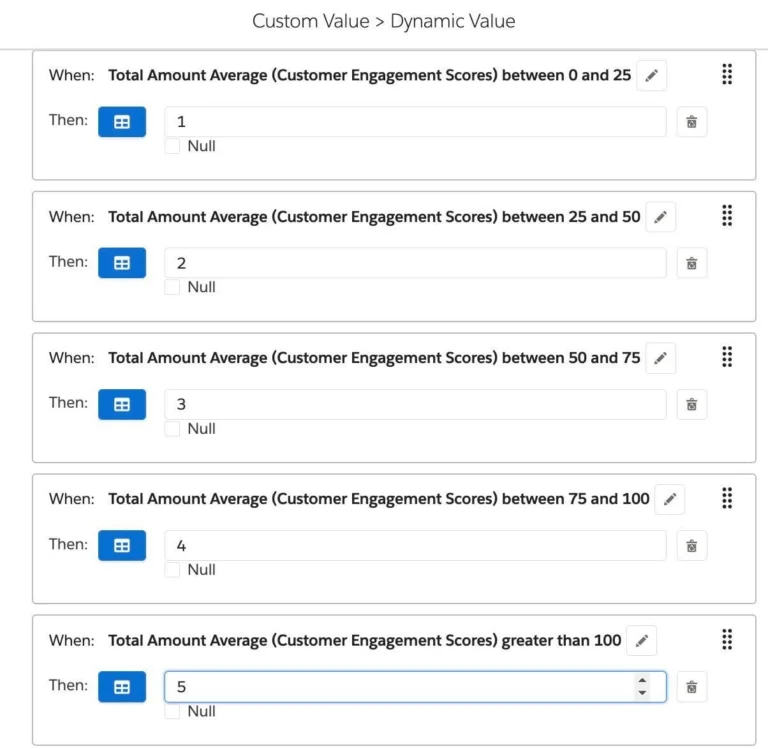
9. We make sure the Default value is 0 and click on Save.
10. We add the created value to our Target DE’s fields.
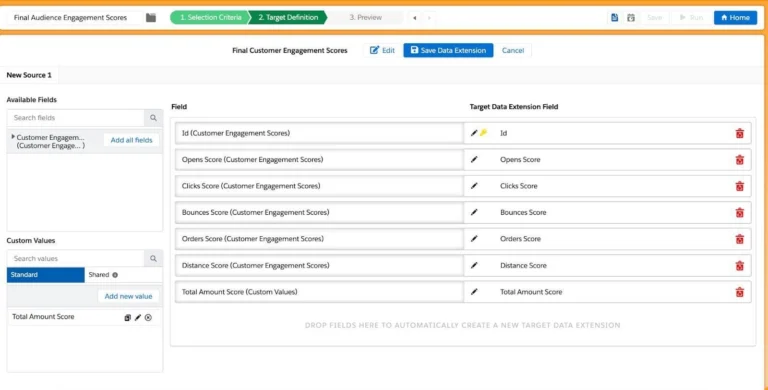
11. At the top click to Save Data Extension, then confirm with Create.
12. Click on Run to create the data extension. You can also Preview beforehand in the Preview section.
Calculate each customer’s Total Engagement Score
After calculating each criteria score separately, it is time to sum them up and end up with a single audience engagement score per customer.
1. Create a new selection and name it Customers With Score.
2. Add our Final Customer Engagement Scores Data Extension.
3. On the target definition screen create a Customers with Score Data Extension.
4. Add the Id field to our Target Data Extension.
5. Click on the Add new value button.
6. Set the name Total Engagement Score, choose Apply formula to a field and click Next.
7. Click Apply any function and Next.
8. Choose Number as the field type.
9. Select the Opens Score field of Final Customer Engagement Scores DE in the dropdown and click Insert Field.
10. Add a plus operator (+).
11. Do the same for Clicks Score , Bounces Score, OrdersScore, Distance Score and Total Amount Score. Though because Bounces has a negative score, we change the plus (+) icon in front of this field to a minus (-). The formula should look like this.
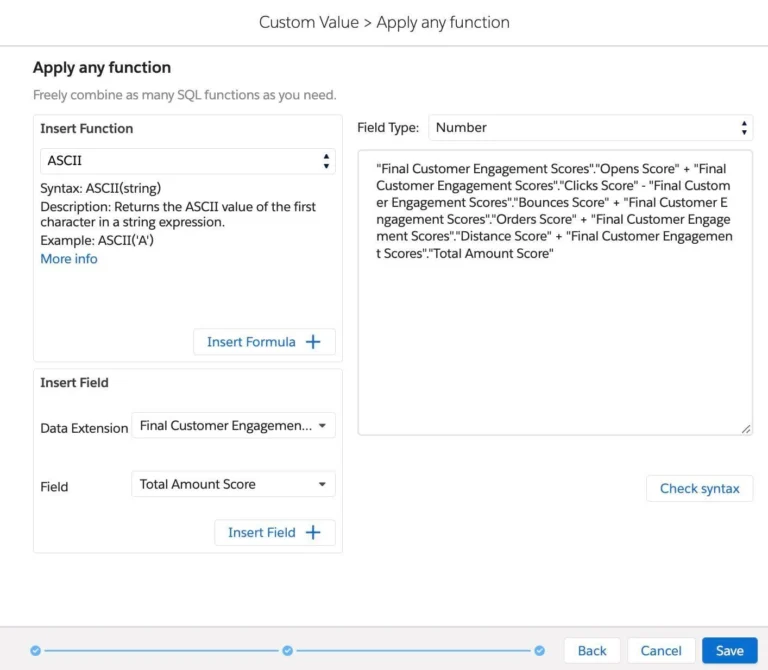
12. Double-check the accuracy of your SQL syntax with Check syntax.
13. Add the Total Engagement Score field to the Target Data Extension.

14. Click on Save Data Extension.
15. Click Create.
16. Click on Run.
Conclusion
After following these steps, you should be able to rank your most valuable subscribers and identify the ones that haven’t been engaging with your content. Just because a customer has a low engagement score, it does not mean they should be crossed out of your contact list. In fact, the opposite is true: contacts with low scores indicate they need a different type of content to engage with.
Engagement scoring is just one way to create detailed audiences that take your customer communications to the next level. Learn how DESelect Segment’s advanced segmentation allows marketers to create highly personalized campaigns based on behavioral data, advanced logic, transaction data, and more – all without code.
Table of Contents
Anthony Lamot: Genna, welcome to the show!
Genna Matson: Hello, thank you.
Anthony Lamot: It’s such a pleasure to have you here. How have you been since the last time we spoke at Connections?
Genna Matson: Good. Busy, but very good. I like to keep things busy.
Anthony Lamot: That’s awesome. Well, I really appreciate the time you’ve taken off your busy schedule to be here with us today. And talking about being busy, you had a very active career up to this point. I see you’re currently engaged in multiple projects, which is pretty cool. Can you tell us a little bit about your trek and what drove you to establish HowToSFMC?
Genna Matson: I’ve been doing this my whole life. I grew up with my dad owning a trade bindery. They work in the printing industry, and I started selling his folders when I was 11, collecting direct mail pieces that were being shipped all over the country. So I feel like I’ve come to this naturally and organically.
Next in my career, I did a short stint in college and dropped out. I claim that now, though I was embarrassed about it for a long time when I was younger.
Anthony Lamot: There you go! I love the confidence.
Genna Matson: Eventually, I ended up back in direct mail and wound up doing data architecture for direct mail, using systems to pull targeted audiences for direct mail, architecting databases that are being used in direct mail, doing mail marches and all that good stuff.
Anthony Lamot: What technology was it back then?
Genna Matson: Microsoft Access and XMPie were what we were using for print at the time. XMPie power is great. It was a Xerox product that allowed for dynamic images to be created and put on direct mail pieces. We were using a technology called Easy Pearl, which would allow personalized URLs. It was honestly not that different from what we use today.
In 2007, we had a client that came to us and said, “We want to try this new thing called email and see if it’s productive for us.” My boss assigned that client to me and I got to work.
Spent a lot of sleepless nights trying to figure out how to make that work. We were using XMPie and Easy Pro to actually send emails.
However, in 2011 XMPie was just not fitting our needs anymore. We needed timeliness in reaching the inbox, and it would take 24 hours for a million records to go out. So if you were trying to do it at the last minute, that’s a problem. So I started kind of poking around the backend of XMPie to fix that, and I saw the term “ExactTarget” everywhere. I did some research on it and that’s how I discovered Salesforce Marketing Cloud. And I was like, “Wait a second, XMPie is just sitting on top of ExactTarget!”
Anthony Lamot: But this was before Marketing Cloud AppExchange was even a thing!
Genna Matson: Yeah, we’re talking before Salesforce.
Anthony Lamot: I didn’t know there were apps that were even layered on top of that. Was it some kind of white labeling?
Genna Matson: Yeah, it was. I don’t know exactly how to describe it because I’m not a web developer and I’m not an app developer, but they had built an application that only used the relays. XMPie had built their own platform, and they were using ExactTarget’s relay. So I don’t know if that’s white labeling exactly … it’s more like an app sitting on top of another app.
This reminds me of a project that I worked on not too long ago. I remember developing one of these back in like 2005. It was horrible. It was a web-to-print solution that allowed marketers to just go in and select, like, a postcard background, layout, etc, and choose the geographical area. But if this was an app for print products, it took me back to my old days. But anyway, email is much more complex than web design.
Anthony Lamot: Interesting, so you kind of stumbled into ExactTarget by exploring the backend of XMPie. What made you say, “Oh, I’m going to make a career out of this thing?”
Genna Matson: I just rolled with it. I say that I’ve done most of everything by accident. That’s why I’m here, you know. We talk about being leaders, and I like to say I’m a reluctant leader. I’m kind of nomadic by nature, and I like to go where I’m curious. It’s because I’m curious that I have this career that was established by accident. I guess you could say I’m not very goal-oriented.
Anthony Lamot: Yes, curiosity is definitely a characteristic that I look for when I bring people into my team.
Genna Matson: I say I’m kind of a reluctant leader because I might decide to jump over a cliff, and I don’t want people to necessarily follow me because they might not see the parachute I’m holding.
Anthony Lamot: Would you say you have a high-risk appetite?
Genna Matson: I think it depends. That’s contextual. I say this after having just left Vegas and only lost $17. I set a budget to gamble only $20 and I was there for 4 days. I’d say I’m risk-averse when it’s not statistically possible for me to win. So, for instance, gambling, it’s too much of a risk – the house is always going to win. They are there to take your money. But as far as careers go, in terms of pushing the boundaries of the platform that we work on, I would say that I’m a risk-taker. I’ll jump over that cliff!
Anthony Lamot: Is that what brought you to HowToSFMC?
Genna Matson: Kind of. HowToSFMC was not my idea, but we are all co-founders.
There are six of us who started it all. It was born out of an email conversation where we were complaining about the lack of support and documentation for Marketing Cloud. We had so many complaints from folks who were promised a lot, but then realized it was not as easy to use the platform as it was described to them in the sales process.
We decided that we wanted to change this. We didn’t want to just make another document repository or blog site, so we started creating these challenges. Cam Robert came up with most of the challenge ideas, including the “Baby Shark” challenge. At the time, he was in our team’s leadership before he joined Salesforce. I also need to give a shout-out to Leslie Higgins. She actually wrote the lyrics for “Baby Shark” in the shape of a shark using AMPscript. It’s on our website, go see it!
Anthony Lamot: Wait, what is this “Baby Shark”? Can you elaborate a little bit on that?
Genna Matson: Baby Shark was the most popular coding challenge we did. The idea for challenges came from us realizing that what Trailhead teaches you is kind of limited. You get to a point where you want to do more, but you can’t learn it from Trailhead. So we thought, “Let’s do code challenges, because Trailhead doesn’t teach you AMPscript.” For the Baby Shark Challenge, we asked people to output the lyrics of Baby Shark using AMPscript.
There were three categories. First, we were looking for the least number of characters, so the shortest code, to output the entire lyrics of the song. The winner used only 156 characters, so kudos to them. That was incredible. The second category evaluated creativity. The judges were me, Adam Spriggs (co-author of The AMPscript Guide), and Greg Gifford (co-author of Automating Salesforce Marketing Cloud). I can’t remember what the third challenge was…
We had tried to give out prizes to encourage the audience, but what we found was that we were leaving out a lot of entry-level folks who wanted to participate in our challenges, but couldn’t because they didn’t have the knowledge. We realized that wasn’t fair and we wanted to make sure that we were including everybody in the Marketing Cloud community. So we decided to kind of shift focus and build the website up, adding content from anyone who would send us stuff.
Anthony Lamot: So are you all pretty active on Slack?
Genna Matson: Yes! Come, talk to us, and ask us questions. The interesting thing is that it’s not just our leadership team that answers questions. We’ve created a self-supporting community, so anybody can participate. So you get feedback from different people with different perspectives from around the world, which is hugely important for even folks like myself who have been on the platform for a decade or longer.
Anthony Lamot: I can testify to just how helpful this community is. We here at DESelect have been exploring additional ways to suppress communications from Marketing Cloud, so I asked about that in your chat and I remember being really surprised by how extensively people answered.
Genna Matson: Thank you. We’re very proud of our community and everybody who participates in it. Even us “dinosaurs” who have been in the industry for a long time learn something new every day.
Anthony Lamot: So what did you discover today?
Genna Matson: I’m embarrassed to admit this, but I’ve just recently learned that when you do a “guided send” from Email Studio, it now creates a User-Initiated Email and stores the send definition there. I didn’t know that, because I usually use either Automation Studio, Journey Builder, or CloudPages.
Anthony Lamot: Wait, you can make a send from CloudPages?
Genna Matson: Oh, yes! Absolutely. It’s probably my favorite part of the platform, along with Automation Studio. In CloudPages, you can do anything you imagine.
Anthony Lamot: But why would you use CloudPages instead of another platform?
Genna Matson: There are lots of reasons. There is a web form that you can collect information from. Additionally, if you want to send an email telling users that they submitted this information or something like that, you could trigger it from that Cloud Page. It’s the same thing as a transactional send, you’re just doing it from a Cloud Page.
Anthony Lamot: I see. Going on a tangent here, when did you learn that “guided send” was remodeled into “transactional send”? Was that a big discovery?
Genna Matson: Yes. That and discovering that it writes a send definition, meaning that it now creates a record of every detail of the send that I can go back and look at. I can check which creative was used, what data set, what classification, etc. Before that, once an email was sent, it was gone. So having that information right on the platform is extremely helpful.
Anthony Lamot: Yeah. And, of course, we all love Salesforce, but we also know that they are notorious for changing their names. You know. It’s funny; I used to be a huge gamer. And some of these games, especially online games, have these sort of “patches” where they can constantly change the rules and the mechanics just to keep the players engaged. I wonder if that same strategy is used by software companies to keep their users interacting with the community.
Genna Matson: I’ve never thought about it that way! I honestly think it’s because they have turnover internally and a lack of documentation – hey, we’re all at a fast pace! Some of us don’t have time and we all fail when it comes to documentation. And that goes true for the people who build the platform, too.
Anthony Lamot: Or they never read the documentation!
Genna Matson: That happens too! They don’t read the documentation, or they don’t ask questions because they think they know the software, but then they go in and break something.
Remember that outage a couple of years ago when the Internet went down on the East Coast, and it ended up being someone at Google who had pushed the wrong code base? Poor guy! I don’t know if he didn’t read the documentation or what the problem was, but he probably got fired.
Anthony Lamot: And in this industry, I feel like people are very smart and more likely to want to do things their own way. The thing is, a lot of times they will waste time trying to solve a problem that already has a solution, but they don’t know that because they haven’t read the documentation.
One recent example that I remember was in CRM mapping, relating to lead sources and original lead sources. After a second group of employees came on board, they started developing a function that was already there.
Genna Matson: There is a lot of redundancy generated from people turning over and transitioning roles. We’re human, we make mistakes.
Anthony Lamot: Absolutely! And as long as we’re willing to learn from them, we will become better.
Moving on, you have a very interesting career path. Starting out in direct mail until, through sheer curiosity and ambition, you find yourself working with Marketing Cloud. Eventually, you start ‘HowToSFMC’.
I’m curious, to what extent have you still been able to tap into your direct mail roots? I know there are some direct mail options out there, such as Optilyz on the Salesforce AppExchange. Have you heard of anything like that?
Genna Matson: Yeah! In fact, there was an AppExchange offering that was a direct mail provider. It can be plugged into the Journey Builder application to send emails and direct mail pieces.
Anthony Lamot: That sounds quite cool. What is it called?
Genna Matson: They’re not public yet so I can’t disclose the name. But when it’s released, I will shout it from the rooftops because it’s pretty cool! It still has to go through security review and all that good stuff. You know how that goes.
Anthony Lamot: Yes, I do. Although, to the credit of our engineering team, we have done a total of four applications, and we’ve always passed the security review on our first try, which our partner manager on the sales side tells us is unheard of. Shout out to our product team!
Genna Matson: That’s impressive, congratulations! But yes, the offering I was telling you about is still working out some of the kinks in their application, it’s in Beta right now.
Anthony Lamot: Just to clarify, the Security Review we’re referring to is a screening that every app needs to go through before being added to the AppExchange. It is notoriously complex to navigate.
Genna Matson: And it should be a difficult process. There is a lot of data there, so there should be a lot of security. There are a lot of ramifications if something goes wrong. I mean, they have every right to scrutinize the apps the way they do, and I think that they do it for the end users and for us engineers.
Anthony Lamot: So Jenna, in your prior roles, what was your most interesting project in SFMC?
Genna Matson: First of all, shout out to Aaron Graves for working with me on that hell project that turned into something beautiful. I say it was a “hell project” because we kept postponing the end date and it ended up becoming a two-year project. They wanted to create a portal for mortgage lenders to go in and enter lead information for loan providers. They wanted it to trigger emails to the loan provider with a list of leads, and then possibly trigger an email or a direct mail piece to those leads from that loan provider.
It was supposed to be a simple automation project, but we ended up building a whole admin section, with reports and everything else. When we were done, it had turned into a direct mail environment.
Anthony Lamot: It sounds like you built your own Salesforce portal.
Genna Matson: Exactly, it was a portal. They didn’t want to go in Marketing Cloud and only wanted one administrator. Back in the day there weren’t a lot of content management systems for websites and things like that. So you would get requests to build out portals, which was hard.
We have the capabilities to do that, but should we? The portal we had built was not the most secure. This was before a lot of security standards that we have today were implemented. I would do it differently today, but it was a good learning experience, and I’m proud of what we produced.
Anthony Lamot: Yeah, it’s fascinating how far you can go with custom development in Marketing Cloud. I keep being amazed at use cases that come up.
Genna Matson: Yeah, and still have documentation for it somewhere.
Anthony Lamot: Oh, look at that! You actually wrote the documentation.
Genna Matson: I did! I used to write really good documentation, and I believe in telling people to write really good documentation, and I do write it for clients who pay for it.
Anthony Lamot: Fantastic. So if there’s one key takeaway from this interview – write and read your documentation.
Genna Matson: And use AI! It will help you write your documentation. I’m using it!
Anthony Lamot: That’s interesting, I hadn’t considered that. Well, since you brought up the subject, let’s switch gears to AI, starting with ChatGPT. How do you use it to write documentation, for example?
Genna Matson: I actually like writing technical documentation (post-bill documentation). I enjoy recording every step of the process of creating a portal or any other project. So I am actually using AI to help me with grammar, or scenarios and edge cases that I might not have seen. It can point out if I missed anything, which is extremely helpful. I also sometimes use it for blueprinting prior to the build because I hate doing documentation in advance.
Anthony Lamot: Can it also be a source for creativity during the early planning stages?
Genna Matson: Absolutely, if that’s your process. Personally, I like to go in guns blazing. You know, some people have different processes. I worked with a developer in the past that liked to do what they called “slamming” into other codes. If they were working with another developer, they would take the codes built independently and “slam” them together. That was their process.
My process is to go in and just start building. I like to have a clear idea of what the goal is, what the pain points are, and who the end stakeholder is. I usually get clients to sign off on blueprints, timelines, pre-build documentations of that sort.
With ChatGPT, I can test scenarios. I can say, “I need to build a journey that has five touchpoints and that has X criteria” and see what it outputs. Then you can engineer and tweak your prompts to better suit your needs.
Anthony Lamot: A really interesting prompt I’ve seen going around the internet is “tell me how to write better prompts.”
Genna Matson: That is a good one. And we have to remember that AI is only as good as what we tell it and as we code it. It does statistical analysis at incomprehensible speeds, something humans just can’t do. However, sometimes it outputs things that are just silly. So you’re gonna have to edit it, you’re gonna have to work it into what you need it to be. It’s not perfect because we’re not perfect, and we created it.
Anthony Lamot: I really like the phrase you used there, “statistical analysis at scale.” It’s closely aligned to our company’s mission statement, which is to “elevate engagement through human intelligence at scale”. I know everything was very different five years ago, when we started.
Genna Matson: It wasn’t that different, though. The first Logic Engine was created in the 1950s. That’s when the term artificial intelligence was coined. It’s more than 70 years old! The term neural networks was coined in 2012, so that terminology is a bit newer, but that branching neural network algorithm has been used for a long time. Even Siri uses it, all your personal devices. Marketers have been using AI for over 20 years. I’ve created algorithms myself before Salesforce’s AI, Einstein.
What is new is the open source base of the code. There are multiple series of conditional statements that the neural network is creating for itself. That’s badass.
Anthony Lamot: So despite having been around for a while and despite all the innovations, there has always been a person in the center of it.
Genna Matson: Right, there is always the human element. Someone needs to prompt the AI. It can get out of control if people use it for nefarious means. I mean, putting aside all the philosophical conversations, AI is just code. It is not alive, and it won’t grow legs and take over the planet.
Anthony Lamot: Opinions vary on that. Some very smart people I know speak up very strongly against AI, but then you have others who fully embrace it.
But as we approach the end of our conversation, I wanted to ask you: What is your favorite part of being a member of the Marketing Cloud community?
Genna Matson: I love the people. I want to thank everybody who sends me messages and shares a little bit of their day-to-day with me. Keep sharing your victories with not just me, but the community in general. It’s you that makes us great!
Anthony Lamot: What was your favorite moment at Connections this year?
Genna Matson: Probably seeing Dan Levy. He is very special to a lot of us, and he might not know a lot about marketing, but his message about acceptance hit really close to home. The special keynote speakers are always the best part of Connections. I’ve seen some really cool ones, like John Lewis. What I also appreciate about Connections is the chance to meet people in the industry. That’s where I first met you!
Anthony Lamot: I will never forget how much Dan Levy appreciates simple newsletters.
Genna Matson: You know, I agree with him!. Thank you for saying that, Dan Levy. I’m on the pro-newsletter side. I love my newsletters. Keep sending them, please!
Anthony Lamot: Genna, you’ve given so much valuable advice throughout this conversation – be curious, remember to document, and newsletters are great. Do you have any other parting advice to Marketing Cloud newbies, or maybe even veterans?
Genna Matson: Don’t be afraid to reach out and ask questions. If you don’t want to do it in public, do it in private. And every single one of us that have been around for a long time, and I am speaking for everybody, we all love when people reach out and ask us questions, even if they’re silly.
You can ask us something like “Hey, is there a way to turn the sky green on Tuesday, using Marketing Cloud?” The answer would be no, but you’re still welcome to ask. We’re all still learning.
Anthony Lamot: Thank you, Jenna, for taking the time today and for doing so much for the Marketing Cloud community. Your passion and curiosity are very inspiring. Thanks again for being here with us today.
Genna Matson: Thank you for having me. This was a lot of fun.

Discover how our platform instantly optimizes your Marketing Cloud
Data Privacy Compliance Across Multinational Teams in SFMC
More than 70% of nations have enacted data protection and privacy laws in the last decade, as shown by the 241 legislations listed on the United Nations Trade and Industry website. The pressing question arises: How do multinational teams navigate the complexities of data privacy compliance, especially when adopting Salesforce Marketing Cloud (SFMC), as it ingests their customers’ data to generate insights and facilitate communication across diverse channels?
Those versed in CRM administration, as well as creative and technical marketing, often attest to undergoing data privacy training preemptively, aligning with regional legislation. Such training is especially important for individuals with system access privileges and those handling the data directly. According to Salesforce’s website, the company diligently monitors the evolving global privacy landscape, adjusting its privacy program to remain abreast of changes. |
This article delves into the influential data privacy legislative and regulatory frameworks impacting multinational teams, the challenges multinational organizations encounter, and how streamlining collaboration can lead to better compliance. It further sheds light on compliance best practices that can be executed using SFMC, encompassing useful system and automation functionality that culminate in effective and efficient communication with subscribers. |
Legal and Regulatory Frameworks Impacting Multinational Teams |
Diverse regulations worldwide emphasize distinct facets of data privacy, focusing on specific rules within each jurisdiction. The landscape of data privacy laws is continually evolving, affecting multinational teams as they navigate compliance across these jurisdictions. This dynamic environment traces back to the initiation of the EU’s General Data Protection Regulation (GDPR) in 2018, serving as a catalyst for the establishment of region-specific data protection laws globally. The GDPR’s foundational principles are:
These principles left their mark on the various laws that followed, prompting multinational teams to devise compliance strategies that align emerging laws with the principles of the GDPR. As illustrative instances, consider subsequent jurisdictional laws such as the California Consumer Privacy Act (CCPA), the Personal Information Protection and Electronic Documents Act (PIPEDA), and the General Data Protection Law (LGPD). The CCPA mandates businesses disclose data sharing practices, providing residents with rights to access, delete, correct, and opt-out of data sharing. PIPEDA, applicable in Canada, safeguards personal information in the private sector, governing its collection, use, and disclosure for commercial activities. LGPD in Brazil safeguards the privacy of personal data collected or processed within the country. Consider a scenario where all the previously mentioned laws apply to a multinational team. To navigate this intricate framework effectively, the team must initially grasp the fundamental principles of the GDPR as a robust foundation. To expand on this, they need to familiarize themselves with the specific data privacy laws governing their operational regions and sectors. A deep understanding of personal data regulations in both their home jurisdiction and others is imperative. Crucially, the team’s digital marketing solutions must align with legislative requirements. By identifying commonalities and nesting pertinent laws, multinational teams can ensure comprehensive compliance. This not only involves adhering to the similar requirements they find, but also addressing diverse and stringent regulations that are specific to jurisdictions, thereby mitigating the risk of costly penalties. |
Challenges and Considerations of Data Privacy Compliance in Multinational Teams |
Multinational teams contend with significant external and internal pressures concerning data compliance, impacting various business drivers such as cost, personnel, processes, technology, quality, and risk scope. Externally, escalating pressure results from the emergence of diverse global legal requirements, which have been characterized as impeding progress in life and business advancements in certain analyses. Internally, organizations must navigate this evolving regulatory landscape, ensuring that their data compliance policies align with changing regulations. Consequently, internal dynamics necessitate continuous updates to data governance structures, intensifying the impact on organizational policies and processes. This confluence of external and internal forces presents growing challenges for multinational teams in adhering to data compliance, resulting in a surge in associated costs. Common initiatives that contribute to this cost escalation include the following.
External forces, such as the rising demand for personalization from customers, add another layer of complexity. To stay competitive, organizations must invest in processes, personnel, and technology to meet evolving customer expectations. This requires navigating the delicate balance between adhering to data regulations that vary across regions and meeting dynamic customer demands. Internally, aligning data privacy compliance policies with multinational contexts introduces further complexity. More resources are spent on tailoring training programs for diverse cultural contexts and to overcome language barriers. This has become essential to address jurisdictional requirements that speak to lawfulness, fairness, and transparency. The industry shift to cloud solutions exposes data to cybersecurity risks, necessitating a steadfast commitment to data integrity and confidentiality. Multinational teams must implement robust data security measures to comply with diverse breach notification requirements. Given the variation in these requirements across jurisdictions, teams must prepare to adhere to different reporting timelines and specifications in the event of a data breach. Moreover, establishing a compliance team in multinational settings poses its own set of challenges. This endeavor is not only costly, but also requires increased accountability, leadership support, alignment with the business’ key performance indicators (KPIs) and establishing appropriate reporting structures. This is further discussed in the below section. |
Streamlining Communication and Collaboration Across Business Units |
The establishment of an effective team for data compliance necessitates not only the identification of suitable personnel but also the assurance that these individuals assume accountability and responsibility for the pertinent compliance processes and data. The imperative here lies in maintaining an open communication loop addressing concerns related to data compliance, accuracy, and accountability. In instances where accountability ownership cannot be discerned, a prudent course of action would be to eliminate the associated data and its interconnected elements. There are various Data Governance Framework suggestions, but in the case of a multinational organization a Centralized Enterprise Data Quality and Governance Team, in collaboration with dispersed teams, is often most effective. The team may comprise of Data Governance Councils and appointed Data Stewards who oversee critical data domains. This includes, for example, designating a Data Steward for Marketing Operations and another for Customer Success and so forth. The role of these stewards is to enforce compliance rules, monitor data quality, and ensure overall data integrity. In the context of multinational operations, it is sensible to designate regional Data Stewards or Business Unit Data Stewards reporting to the Centralized Enterprise Data Quality and Governance Team. Their mandate would involve overseeing processes, ensuring accountability, monitoring data quality, and upholding security rules. This structure will empower individual business units to articulate the purpose of their data, take responsibility for its accuracy, manage access permissions, and ensure data consistency. The Centralized Data Quality and Governance Team assumes a pivotal role not merely in appearance but in substance, requiring the formalization of programs designed to address financial losses, mitigate data privacy compliance risks, and navigate the continual evolution of data compliance standards. These programs may be extended to regional implementation where required and administered through collaboration with the designated Data Stewards. These programs are crucial for organization-wide compliance and to secure the support and engagement of organizational leadership, especially when Data KPIs align with overarching Business KPIs. Alignment will elevate the significance of data governance beyond mere regulatory adherence to a strategic imperative integral to the organization’s mission. |
Best Practices for Ensuring Data Compliance in Salesforce Marketing Cloud |
As highlighted earlier, the impact of data compliance on revenue and costs requires thorough internal data governance practices and policies. It is imperative to also ensure alignment across your SFMC instance. Here are some recommended best practices within SFMC, which is not an exhaustive list. Business Unit PartitioningIn a multinational company, distinct business units may operate under the same enterprise account in SFMC. Your governance framework may dictate that these units should not access each other’s data. Configure this in SFMC by navigating to Setup/Business Units. For data sharing between business units, consider using shared data extensions and establish permissions using SFMC Data-Extension policies. Field-Level EncryptionTo enhance compliance with data privacy policies or regulatory requirements, activate field-level encryption, particularly for email addresses in SFMC. This added protection sets selective encryption for desired fields of a data extension before it is sent to Marketing Cloud. This ensures sensitive data remains private from Salesforce and any team members without proper clearance. Administrator Roles and PermissionsAlign your SFMC Administrator Role with your Data Governance Framework on access controls and permissions. Utilize SFMC standard roles like Marketing Cloud Administrator, Marketing Cloud Viewer, etc., or customize roles to fit your organizational structure. Send Classification SetupLeverage your governance framework to guide the setup of Send Classifications (promotional/commercial or transactional emails) in SFMC. This includes configuring sender profiles (email addresses used for sending) and delivery profiles (standardized headers and footers) to ensure compliance with regulations such as CAN-SPAM. Content Management and TaggingImplement tagging in SFMC to manage and identify content subject to specific regulations and policies. This facilitates easy tracking, identification, and management of created content, thereby customer communications remain compliant. Data Retention PoliciesRefer to your Data Governance Framework to determine the duration for which data should be retained. Configure and edit data retention policies within SFMC Data Extensions accordingly. Contact Data Deletion ProcessUtilize the available manual process in SFMC for deleting all related data to a contact. This can be done through the Contact Builder in the All Contacts tab and all data will be deleted related to this contact. Consider automating this process, through development, to streamline data removal. Regular Compliance Audits and TrainingConduct regular data privacy compliance audits and assessments. Ensure that all staff with data access undergo training to be well-versed in the organization’s data governance policies and relevant jurisdictional requirements. This proactive approach minimizes the risk of non-compliance. By adhering to best practices and continuously assessing and educating your staff, your organization can effectively navigate the complexities of data compliance within SFMC, thereby mitigating potential financial impacts. |
Data Compliance Automation in Salesforce Marketing Cloud |
Aligned with data privacy and compliance best practices, SFMC offers automated functions to facilitate adherence to compliance standards. SFMC recommends the deployment of monitoring tools, such as Google Postmaster Tools and SNDS with Microsoft, to oversee IP and Domain reputation, detecting potential issues like compromised servers, malware, viruses, and botnets. SFMC also equips users with tools and functionalities which, if implemented diligently and according to jurisdictional rules, can ensure compliance. Here are some automation features that can be set up within SFMC: Automate Subscriber Consent Management
Automate Contact DeletionAddress right-to-be-forgotten regulations by automating contact data deletion in SFMC. This may involve further development efforts to ensure data privacy compliance. Alternatively, contacts can be added to do-not-send contact lists, acting as an auto-suppression list to prevent further sends to unsubscribed or problematic contacts. Automated Restrictions on Data ProcessingLeverage the Marketing Cloud REST API to automate restrictions on data processing for specific contacts. This helps marketers adhere to subscribers’ privacy preferences when managing their data. Unsubscribing Nonactive RecipientsAlthough SFMC doesn’t automatically unsubscribe nonactive recipients, it does recognize bounced emails, preventing further communication in the case of hard bounces (user unknown or domain errors). Automate Audience SegmentationUse filter activities and queries in SFMC to automate the segmentation of audiences. This ensures that campaigns are directed to targeted audiences based on their preferences and consent, enhancing relevance. Automate segmentation of audiences for relevant content sends in SFMC with filter activities and queries. This will create targeted audiences for campaigns and ensure that your marketing messages are directed only to individuals who will find the information relevant and have given their consent. Speaking of automating segmentation, DESelect removes the need for code when creating audiences, empowering all marketers to create the audiences they need. Learn how even brands in highly regulated industries, like financial services company Alm. Brand, have cut the time it takes to segment in half while remaining in compliance with privacy regulations. SFMC can integrate with other compliance tools and services. This can include tools for data anonymization, data masking, and other solutions that help in maintaining compliance with regulations. |
Conclusion |
In summary, effectively maneuvering through the intricate landscape of data privacy compliance across multinational teams, utilizing SFMC, demands a meticulous and committed approach. This involves assigning explicit roles and responsibilities for continuous accountability and responsibility. With over 70% of nations implementing data protection laws in the past decade, addressing compliance intricacies is paramount, affecting organizational data governance policies and procedures. |

Suzaan Groves
Suzaan is a Project Director at Cloud-Vision, where she specializes in managing projects related to Salesforce Marketing Cloud implementations and development. She has been part of project implementations in various sectors including automotive, retail, government and financial services. Suzaan is a certified Project Management Professional (PMP), and she holds an MBA from the University of Stellenbosch.
Table of Contents
Ensuring Data Is Ready For Marketing Campaign Launch
In today’s digital landscape, where customer experiences reign supreme, the strategic use of data has become a pivotal factor in achieving success in each marketing campaign launch. Your ability to harness and leverage data effectively often means the difference between a captivating customer journey and one that falls short of expectations.
To navigate this data-driven world with finesse, one tool stands out as a beacon of opportunity: Salesforce Journey Builder.
We’ll embark on a comprehensive exploration of how to prepare your data for seamless integration with Journey Builder.
This isn’t solely about automation; it’s all about creating personalized and meaningful experiences for your audiences. Come along with us as we explore the details of data storage, taxonomy, and deployment, making sure your data is prepared to power the vibrant customer journeys you’ve envisioned.
The path to success begins here, as we decode the secrets to maximizing the potential of Journey Builder through smart data practices.
Buckle up, and let’s prepare your data for a journey of a lifetime.
The Foundation: Optimal Data Storage
Benefits of Best Practice Data Storage
A top-notch data storage strategy has numerous advantages if carefully planned and implemented. For example:
- More secure data: This is because measures are taken to mitigate threats and provide ongoing visibility into data access patterns and potential risks.
- Compliance: Ensure data and storage management complies with applicable regulations and can meet auditing requirements.
- Continuous use: Systems, processes and data protections are put into place to ensure ongoing availability and reliability, resulting in greater user productivity and customer satisfaction.
- Long term use: Storage devices provide the capacity necessary to meet current and future workloads, while accommodating different types of data, without over-provisioning storage hardware.
- Adaptable operations: Storage systems are flexible enough to scale as demand fluctuates, while reacting to changing requirements and accommodating new storage technology.
- Comprehensive: Storage systems are easier to manage and monitor, and deploying storage devices is faster, often without the compatibility and integration issues that come with siloed or piecemealed storage systems.
Data Storage Options For Marketing Cloud Teams Within SFMC
In the world of Salesforce Marketing Cloud, the choice between Lists and Data Extensions is a pivotal decision, one that can significantly impact the efficiency and effectiveness of each marketing campaign launch. Both options come with their unique advantages and disadvantages, making it essential to evaluate which aligns best with your campaign needs.
What Are Salesforce Marketing Cloud Lists?
In Salesforce Marketing Cloud’s Email Studio, lists serve as a foundational approach for managing subscriber data. Essentially, a list in this context is akin to a digital roster, compiling a group of subscribers. This setup facilitates the task of dividing your audience into distinct segments for targeted communication.
When you add subscribers to a list, you have the capability to assign various attributes to them. These attributes act like labels or markers, offering insights into each subscriber’s current engagement or status in relation to that specific list. For instance, you might track whether a subscriber is active, inactive, or has opted out of communications.
However, it’s important to note that the use of lists is more suitable for scenarios where the total number of subscribers doesn’t exceed 500,000. This limitation is crucial to keep in mind for scalability and efficiency reasons. Lists are particularly effective for straightforward subscriber models, where the primary focus is on basic subscriber management without the need to delve into more complex data like transactional history or detailed commercial interactions.
Moreover, lists in Salesforce Marketing Cloud are also adept at handling personal subscriber data. This means you can manage information such as email addresses, names, or other personal details within these lists, ensuring that your communications are personalized and relevant.
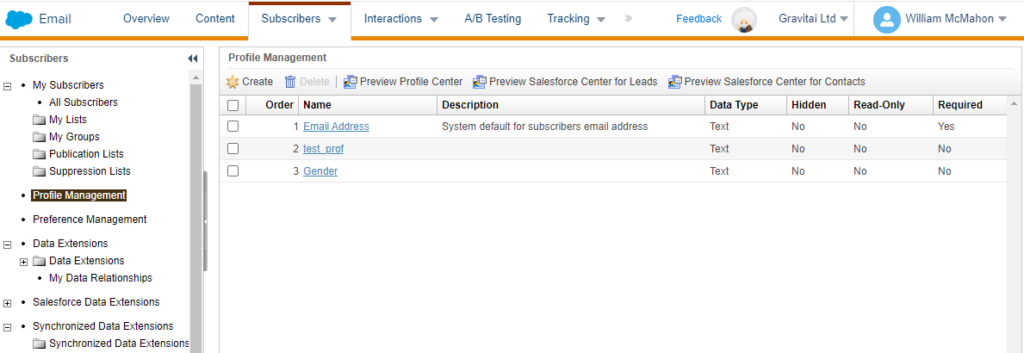
Image: Lists use ‘Profile Attributes’ which are applied consistently across all Lists in SFMCAdvantages of Lists:
Simplicity: Lists are straightforward to create and use, making them an excellent choice for simple email sends. With Lists, you can quickly import email addresses and start sending campaigns without intricate setup.
Basic Segmentation: Lists enable basic segmentation based on attributes like email addresses, suitable for simpler campaigns.
Disadvantages of Lists:
Data Duplications: Duplicate email addresses across different Lists can lead to data inconsistencies and maintenance challenges.
Limited personalization: Profile Attributes in SFMC are essentially standard fields that store subscriber information. When using Lists, these attributes are applied universally across all lists. This means that every list you create will share the same set of Profile Attributes, such as name, email address, and other basic subscriber details. Lists may not offer the level of personalization and dynamic content that Data Extensions provide.
Scalability: Lists are suitable to Subscriber counts below 500k records and for a simple (flattened) data model.
Usability in Journey Builder: Journey Builder does not support the use of lists as a data entry source.
What are Data Extensions?
In the realm of Salesforce Marketing Cloud, Data Extensions offer a versatile and robust way to manage and manipulate subscriber data, going beyond the basic capabilities of lists. Think of Data Extensions as sophisticated, customisable tables capable of storing vast and varied types of data, akin to spreadsheets but with enhanced functionality and integration capabilities.
Unlike lists, Data Extensions allow for a more intricate and detailed structuring of subscriber information. You can create multiple columns in a Data Extension, each designed to hold specific types of data, such as text, numbers, dates, or even Boolean values. This flexibility enables a deeper and more nuanced understanding of your subscribers, allowing for highly targeted and personalized marketing campaigns.
One of the key strengths of Data Extensions is their scalability. They comfortably handle large volumes of data, making them ideal for organizations with extensive subscriber bases or those dealing with complex data sets, including transactional details, behavioral data, and more.
Moreover, Data Extensions are not just siloed data repositories. They are designed to seamlessly integrate with other parts of the Salesforce Marketing Cloud ecosystem, such as Journey Builder and Automation Studio. This integration means that the data within Data Extensions can trigger specific actions, feed into automated marketing workflows, and inform real-time interactions with subscribers.
Furthermore, Data Extensions provide advanced segmentation capabilities. You can use SQL queries to segment and manipulate data, offering a level of precision in targeting that goes beyond basic lists. This feature is particularly valuable for creating highly customized marketing campaigns or for performing in-depth data analysis.

Image: Data Extensions allow you to create Fields/Attributes specific to each Data ExtensionAdvantages of Data Extensions:
Flexibility: Data Extensions are highly adaptable and can store a wide range of data fields, making them suitable for comprehensive customer data storage.
Robust Segmentation: Data Extensions offer advanced segmentation capabilities, allowing targeted campaigns based on multiple attributes.
Personalization: Data Extensions empower you to create highly personalized and dynamic content, catering to individual subscriber attributes.
Disadvantages of Data Extensions:
Complexity: Data Extensions can be more intricate to set up and manage, especially for handling large volumes of data and complex relationships.
Data Hygiene: Greater flexibility necessitates diligent data hygiene efforts to maintain data quality.
In summary, Lists are ideal for simpler campaigns with basic segmentation and uncomplicated list management. On the other hand, Data Extensions offer more flexibility, segmentation capabilities, and personalization options.
However, they require a deeper understanding of Salesforce Marketing Cloud and additional attention to data hygiene.
Ultimately, your choice should align with your specific marketing campaign launch needs and your team’s familiarity with Salesforce Marketing Cloud. For complex, personalized campaigns, Data Extensions are often the preferred choice, offering the versatility and capabilities needed to drive marketing success.
External Data Storage: How To Connect to SFMC
Integrating Salesforce Marketing Cloud with external data storage solutions presents both opportunities and challenges. The choice between local Marketing Cloud storage and external storage hinges on data volume, complexity, and specific use cases. Let’s explore the advantages and disadvantages of both approaches:
Integrating with External Data Storage
While many businesses use an external database or CRM as their primary source of customer information, integrating these systems with Salesforce Marketing Cloud (SFMC) is essential for effective email marketing. In practice, businesses often synchronize key customer data from their master database into SFMC.
This approach allows for maintaining detailed and specific records externally while leveraging SFMC’s robust email marketing capabilities. The synchronization process involves importing essential information into SFMC that is crucial for segmenting and personalizing email campaigns. For more nuanced and detailed data, SFMC can access the external database via API calls. This method retrieves additional insights and information as needed to further tailor and enhance email communication.
Employing this integrated approach ensures that email campaigns are both personalized and relevant, drawing on a comprehensive understanding of customer profiles from both the SFMC and the external database systems. This strategy strikes a balance between the richness of data from the external databases and the specialized marketing tools available in SFMC.
Pros:
Data Consolidation: External storage centralizes customer data from multiple sources, providing a comprehensive view of your customers by consolidating data from Salesforce, external CRMs, and third-party systems.
Data Enrichment: External storage enriches customer data with additional information, such as demographics or behavioral data, augmenting your understanding of customers.
Advanced Analytics: Data stored externally can be more accessible and amenable to advanced analytics tools, offering deeper insights for personalized marketing campaigns.
Real-time Data Sync: Many external data storage solutions offer real-time data synchronization, ensuring you have the latest customer information available for your campaigns.
Cons:
Complex Integration: Integrating external data storage with Salesforce Marketing Cloud can be intricate and may require custom development, APIs, or middleware solutions.
Data Security: Maintaining data security and compliance across external storage can be more challenging and may necessitate additional security measures.
Data Latency: Depending on the integration setup, accessing external data may introduce some latency, potentially affecting the real-time nature of your marketing campaigns.
Using Local Salesforce Marketing Cloud Storage
Using local Salesforce Marketing Cloud storage as an alternative to integrating with external databases involves importing larger quantities of data directly into SFMC.
This approach is particularly viable when businesses prefer to have immediate access to a substantial amount of data within their marketing platform for quick campaign launches. However, it’s crucial to import only data that is relevant to the marketing campaigns to maintain efficiency and relevance.
Mirroring the data architecture of the source system within SFMC is recommended to ensure consistency and ease of navigation. The data can be imported either through a Batch File Import Process or via API, depending on the volume and frequency of data updates required.
It’s important to note that in this model, SFMC serves as a “slave” to the source system, meaning it reflects the data from the primary database but does not override or become the master repository of data. This approach allows SFMC to utilize a comprehensive set of data for enhanced targeting and personalization in marketing campaigns while maintaining the integrity and primary control of data in the original source system.
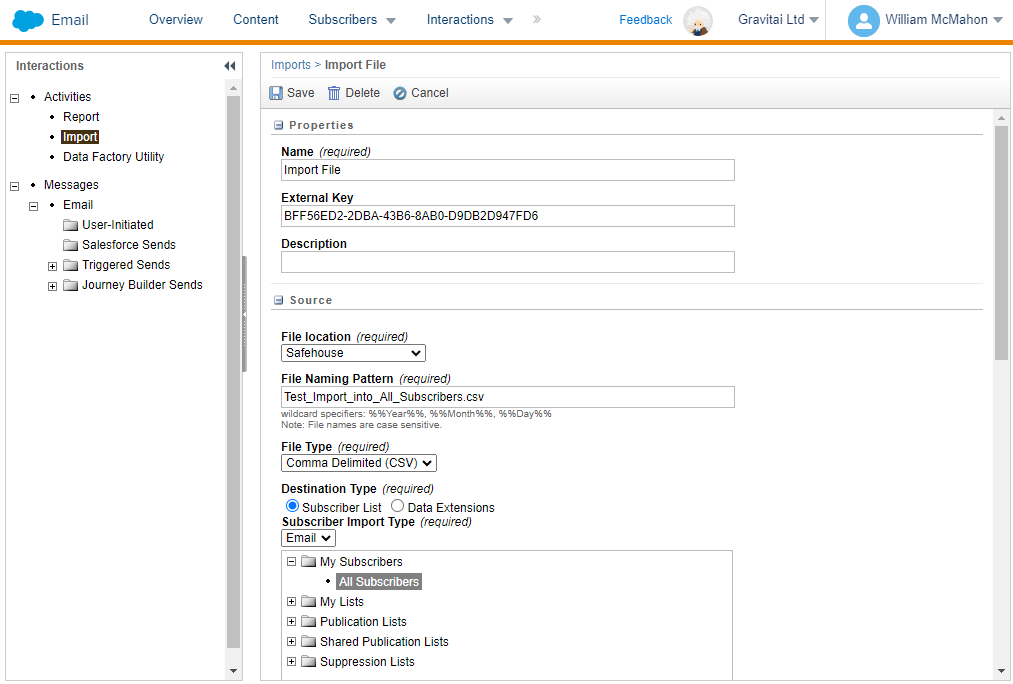
Pros:
Simplified Setup: Local storage in Salesforce Marketing Cloud is straightforward and requires no external integrations. It’s an out-of-the-box solution.
Data Privacy: Local storage provides a higher level of data privacy and control. This is a critical factor for businesses that need to adhere to strict data security and compliance standards.
Out-of-the-Box Integration: Local storage seamlessly integrates with Salesforce Marketing Cloud’s native features, making it suitable for standard use cases.
Cons:
Storage Limits: Salesforce Marketing Cloud has storage limits that may be insufficient for organizations with large volumes of customer data.
Data Fragmentation: Using local storage may result in fragmented customer data, particularly if data is spread across different Salesforce instances.
Data Security and Compliance: The importance of maintaining data security and compliance with relevant regulations
Getting ready for a campaign launch is a meticulous undertaking, with each detail carefully planned to secure success. Amidst many strategic factors, it’s vital to keep a keen focus on data security and compliance.
In the contemporary landscape, ensuring data security and compliance with applicable regulations is not merely a recommended practice – it’s an absolute necessity.
Data Security: Protecting your data from unauthorized access and breaches is paramount. Whether it’s customer information, transaction records, or sensitive campaign data, robust data security measures are essential. Implementing encryption, access controls, and regular security audits are just a few strategies to fortify your data’s defenses.
Regulatory Compliance: When it comes to data protection regulations like GDPR, HIPAA, or CCPA, it’s not just a matter of checking boxes – it reflects an organization-wide commitment to treating data with respect and responsibility. Failing to comply can result in significant consequences, from legal penalties to reputational harm. To maintain compliance, it’s crucial to stay updated on the latest regulations, put the necessary processes in place, and routinely conduct audits.
Customer Trust: Beyond legalities, data security and compliance play a crucial role in building and maintaining customer trust. When your customers know their data is handled with the utmost care and in line with legal standards, they’re more likely to engage with your campaigns and share their information with confidence.
In conclusion, data security and compliance are integral components of campaign readiness. They ensure that your data is not only prepared for campaign success but also protected from potential pitfalls. Prioritizing these aspects safeguards your reputation, strengthens customer trust, and enables your campaigns to thrive in an environment of data privacy and security.
Data Quality Assurance: Ensuring Data Integrity and Cleanliness
As marketers, we understand the power of data in crafting compelling and effective campaigns. It’s the lifeblood of our strategies, driving us toward our goals and objectives. However, data alone is not enough.
It’s the quality of data that truly makes the difference. That’s where Data Quality Assurance steps in, playing a strategic role in ensuring data integrity and cleanliness for a campaign launch that hits the mark.
Data Integrity: The first pillar of Data Quality Assurance is maintaining data integrity. This ensures that your data remains accurate, dependable, and consistent. Inconsistencies or errors within your data could potentially lead to costly mistakes and the dissemination of inaccurate information, ultimately undermining the effectiveness of your campaign.
Data Cleanliness: Data must be free from errors, duplicates, and inconsistencies. Ensuring data cleanliness is crucial to prevent costly mistakes in your campaigns, such as sending multiple emails to the same recipient or reaching out to the wrong audience.
Data Readiness: Data Quality Assurance involves making sure that your data is ready for marketing campaign launch. This means it’s well-structured, properly formatted, and available for immediate activation when you need it.
By giving prominence to Data Quality Assurance, you’re not just avoiding costly mistakes but also guaranteeing that your campaigns are founded on precise and trustworthy data. This, in effect, boosts the accuracy and effectiveness of your marketing endeavors, resulting in superior outcomes and a deeper connection with your audience.
Organizing Your Data: Taxonomy
Data taxonomy involves creating a hierarchy of categories and subcategories used to classify and organize data consistently and logically so datasets can be understood quickly.
The Benefits of Implementing Data Taxonomy
- Better Decision-Making: We’ve all been in a situation where the power of hindsight would have been helpful when deciding to create a more positive outcome. However, you can access a similar superpower to help in these situations simply by accessing the correct information in an efficient manner.
- Better Clarity and Communication: When the definitions of specific terms are clear, the data’s sources and meanings are clear. With these definitions and data organized, you can achieve more clarity and communication within your marketing operations.
- Better Data Quality: Building a data taxonomy within your business gives greater confidence in the quality of your data. Because there is a clear understanding of the structure of your data and a consistent naming convention and concise definitions, it helps to avoid errors and highlight if there are any inconsistencies in the data.
- Avoid Duplication: Another benefit of data taxonomy is the avoidance of duplication. A clear understanding of your data shows what datasets have been created so you can easily see if what you need already exists.
For example, if someone in marketing was looking for the lifetime value of a set of customers, they could check the database to see if this exists before requesting it.
Creating a Data Taxonomy Framework
Preparing your data for a successful marketing campaign launch is a pivotal step in ensuring that your marketing efforts hit the bullseye.
To achieve this, it’s crucial to establish a robust Data Taxonomy Framework. This framework encompasses three key elements: Categorization and Hierarchy, Naming Convention, and Metadata and Tagging.
- Categorization and Hierarchy: Start by categorizing your data into logical groups. Create a hierarchy that reflects the relationships between these categories. This structure aids in organizing data, making it easier to locate and work with, ultimately enhancing campaign precision.
- Naming Conventions: Consistency is key. Implement a standardized naming convention for your data elements. Having a well-established naming convention simplifies data comprehension and utilization for team members. It minimizes mistakes and guarantees that everyone is aligned and working together smoothly.
- Metadata and Tagging: Metadata provides context to your data. It describes its characteristics, origins, and usage. Coupled with tagging, metadata allows for quick and searchable data discovery. Properly tagged data simplifies the process of finding the right elements for your campaign.
By establishing a Data Taxonomy Framework that incorporates these elements, you create a solid foundation for your data.
This, in turn, guarantees that your campaign launch is not only seamless but also customized to engage the right audience with the right message. Be sure not to underestimate the significance of these fundamental data preparation steps – they can be the decisive factor in your marketing success.
Integration With Journey Builder
Salesforce Marketing Cloud Journey Builder is a dynamic and powerful tool designed to create personalized customer journeys. This studio allows marketers to craft tailored, multi-step interaction paths based on customer behavior, preferences, and data.
Think of a journey as a roadmap that guides each customer through a series of customized experiences and interactions with your brand. Journey Builder enables the orchestration of these experiences across various channels like email, mobile, social media, and more. It leverages real-time data and customer actions to adapt the journey dynamically.
In an example scenario, when a customer abandons a shopping cart, Journey Builder triggers a personalized email to bring them back. It’s not just about sending messages but about creating meaningful, timely, and relevant interactions that resonate with each customer. With its drag-and-drop interface, Journey Builder makes it easy to visualize and design these complex customer journeys, enhancing the overall customer experience and fostering deeper engagement.
Salesforce Journey Builder Integration is a multi-step process that requires careful planning and execution to maximize its potential. Let’s explore the key aspects of this studio.
Understanding The Significance of Journey Builder
Journey Builder goes beyond a mere marketing automation tool; it’s a strategic platform that empowers you to craft customer journeys that captivate and convert.
Delve into its core features and advantages to unlock the full potential of Journey Builder, making it a cornerstone of your marketing strategy.
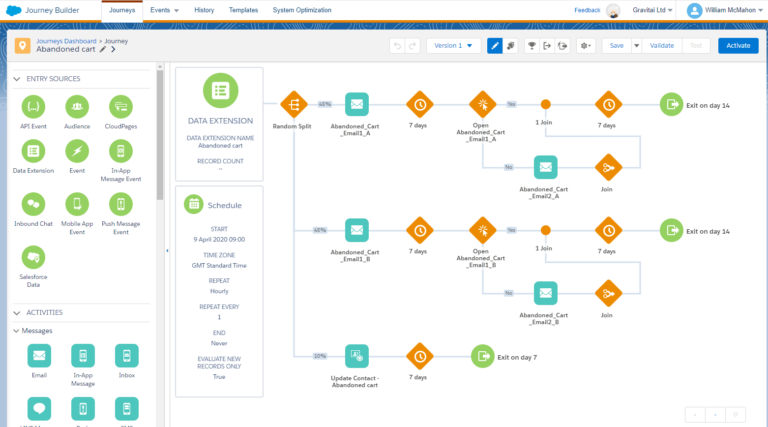
Quick Journey Builder Intro
To begin, let’s dive into some of the key features and advantages of Journey Builder:
Multi-Channel Marketing: You’re empowered to interact with your customers through a diverse array of channels, spanning from email and SMS to the vibrant world of social media.
Segmentation: You can segment your audience for highly personalized messaging and offers.
Automation: Automation simplifies and streamlines your marketing efforts, saving time and resources.
Tracking and Reporting: Comprehensive analytics provide insights into your campaign’s performance.
Key Components of Journey Builder
Before diving into data preparation, let’s briefly review the fundamental components of Journey Builder:
Entry Sources: These are key repositories for where journey data comes from. They include Data Extensions, APIs, Cloud Pages and more. Note that you cannot start a journey using a List.
Activities: These represent the steps in a customer journey, such as emails, SMS messages, and wait times.
Triggers and Events: These initiate journeys based on customer actions or external events.
Decision Splits: These allow you to branch your journey based on actions, conditions or customer attributes.
Goals and Exits: These help to determine when a customer journey is considered successful and how it should end.
Data Preparation for Journey Builder Integration
Now that we have a basic understanding of Journey Builder, let’s focus on preparing your data for a successful integration. The effectiveness of your customer journeys heavily relies on the quality and structure of your data.
To make the most of your integration process, ensure data is thoroughly reviewed and cleaned to maintain data accuracy and consistency. This proactive step will ensure whatever data used for marketing campaign launch or impactful customer journeys will unlock the full potential of Journey Builder.
Here’s a detailed breakdown of the key steps to ensure your data is Journey Builder-ready.
Data Mapping: Aligning Stored Data with Journey Builder Requirements
Mapping your existing data to Journey Builder requirements is the first step in the data preparation process. It involves identifying and aligning the data fields in your current storage with the fields required by Journey Builder. This step ensures that your data seamlessly flows into the Journey Builder without any hiccups.
Key Considerations For Data Mapping
- Identify the essential customer data fields for your journeys
- Match your existing data fields with Journey Builder’s data extension fields
- Ensure data consistency and accuracy throughout the mapping process
Data Formatting and Transformation: Ensuring Data Is in the Right Format for Seamless Integration
Once you’ve mapped your data, the next step is to ensure it’s in the right format for integration. This involves cleaning and standardizing your data to ensure consistency. Inconsistent data can lead to issues during the integration process. Data formatting and transformation are crucial for a smooth Journey Builder experience.
Best Practices for Data Formatting
- Date Formats: Use a consistent date format (e.g., YYYY-MM-DD) to avoid confusion.
- Currency Symbols: Standardize currency symbols and ensure they are consistently applied.
- Duplicate Data: Remove duplicate entries to maintain data accuracy and reduce redundancy.
- Data Completeness: Verify that customer records are complete with all necessary information.
- Data Cleanliness: Cleanse data to remove any inconsistent or irrelevant information.
Testing and Validation: Strategies for Checking Data Integrity Before Deployment
Testing and validation are pivotal in the data preparation process. Before you launch your journeys, it’s essential to thoroughly test the data’s integrity. This includes checking for any missing or incorrect data, as well as verifying that the data flows correctly within Journey Builder. Comprehensive testing minimizes the risk of errors during deployment.
Data Validation Steps
- Conduct data integrity checks with data validation tools.
- Test your journey flows and interactions with sample data.
- Ensure that your data extensions are up to date.
Issues You Can Encounter in Journey Builder When Creating New Versions
Journey Builder is a dynamic tool, and as with any technology, updates and new versions are common. In this section, we’ll explore potential issues that you might encounter when creating new versions of your customer journeys.
Being aware of these challenges can help you proactively address them, ensuring a seamless transition to the latest Journey Builder version.
Common Challenges in Journey Builder Version Updates
- Compatibility issues with existing journey configurations
- Changes in data extension requirements
- Impact on existing customer journeys and their performance
Each of these may require manual quality assurance upon every update – testing, diagnosing, and remedying.
Setting a Data-Driven Course: Your Journey Begins Here
As we conclude this comprehensive guide, we hope you’ve gained valuable insights into preparing your data for seamless integration with Salesforce Journey Builder. It’s been a journey, exploring the critical foundations of data storage, mastering data taxonomy, and unlocking the potential of Journey Builder.
Now, let’s take a moment to pause and look back at the journey you’ve embarked upon. In this concluding section, we’ll bring together the essential lessons, strengthen your grasp of best practices, and ensure every one of your data-driven marketing campaign launch can set off with confidence.
In the opening chapters, we emphasized the significance of optimal data storage. You learned how proper data management is the bedrock of any successful marketing campaign. Remember, maintaining clean, well-organized data leads to streamlined processes and insightful decision-making.
Taxonomy: The Art of Organization
Our journey through data taxonomy revealed the art of structuring your data. By creating a robust framework, you set the stage for data that’s easy to retrieve, analyze, and activate. The use of naming conventions, metadata, and categorization helps your data become a powerful asset.
Journey Builder Integration
As we ventured into the realm of Journey Builder, you discovered how this tool can propel your marketing efforts to new heights. The importance of data mapping, formatting, and thorough testing cannot be overstated. These are the pillars that uphold your data’s success in Journey Builder. Keep in mind that Journey Builder does not work with Lists.
Best Practices for Data Governance
Data governance and documentation are not the final destination but rather a continuous process. Establishing protocols and routines for data management are key to maintaining the quality and security of your data.
Continuous Evolution
The world of data never remains static. It’s ever evolving, much like your customers’ needs and expectations. Ensure that your data strategies are scalable and future-proof, allowing you to adapt and grow as your data requirements change.
Your Data-Driven Journey Awaits
It’s important to remember that the road ahead has hurdles. You might encounter challenges, but armed with the knowledge you’ve gained, you’re more than equipped to navigate them. Whether you’re a seasoned marketer with years of experience under your belt or someone just beginning to explore the possibilities, always keep in mind that data is not an adversary but a trusted ally by your side.
Your success lies in your commitment to data excellence, from storage to integration, and beyond. It’s a journey where data becomes a powerful asset, and Journey Builder becomes your canvas for crafting remarkable customer experiences.
So, what’s next for you? It’s time to put theory into practice, to experiment and explore. Your journey begins here. Take those insights, experiment, and make data your trusted companion in your marketing endeavors.
Thank you for joining us on this data-driven expedition. Safe travels, and may your path be paved with data-driven success.
DESelect makes it easy to standardize how your team uses SFMC for maximum efficiency. Learn how marketers instantly find any object in Marketing Cloud with DESelect Search – free on the AppExchange!
Table of Contents

William McMahon
CEO & Founder at Gravitai, William has over 15 years experience in the CRM world as both a top UK Salesforce Partner and Ex-ExactTarget Principal Solutions Architect.
Ensuring a Seamless Salesforce Marketing Cloud Data Migration
Data migration specialists adhere to essential best practices to ensure a seamless transition and preserve data integrity and reliability. Following migration best practices also minimizes risks and saves you time, resources, and potential headaches in the long run.
Whether you are transitioning to Salesforce Marketing Cloud from a legacy system or transferring data from other platforms, it is imperative to follow established best practices. Your efforts will significantly influence your ability to build audiences, personalize campaigns, and ultimately drive business growth.
In this article, we delve into Salesforce Marketing Cloud data migration best practices tailored for migration architects and business process owners to position you for success. While each business context and use case may introduce unique complexities that we cannot cover in this brief post, we can provide you with an overview that will prove valuable for your upcoming migration project.
Follow these recommended data migration best practices for a seamless transition and achieve the highest data quality outcomes for your migration.

Stage 1: Determine Why, When, and How Data Will Migrate
Define Objectives Clearly
Commence the migration process by establishing clear objectives from the outset, a pivotal step in ensuring the efficiency of the entire process. Begin by precisely defining the scope of your data migration endeavor, including the specific datasets you intend to transfer and their respective volumes.
To make informed decisions regarding data quality and relevance, engage in meaningful discussions with business process owners and data custodians. Their insights can help you determine the significance and reliability of the data you plan to migrate. In some cases, these conversations may lead to the realization that migrating only essential data is the most prudent course of action, aligning with industry best practices and ensuring a more focused and streamlined migration effort.
Additionally, it is imperative to establish a requirement to articulate the precise purpose and utility of significant data sets. This clarity not only aids in decision-making but also serves as a valuable reference point throughout the migration process, helping you stay aligned with your objectives and deliver a successful Salesforce Marketing Cloud migration.
To successfully execute a substantial migration project, it’s essential to engage the following key stakeholders:
- Project Sponsor: This role provides the necessary funding and support to ensure the project’s success.
- Business Process Owners: This group comprises various roles responsible for the effective operation of impacted business processes. Their insights and cooperation are vital for alignment.
- Product Owner: An experienced professional well-versed in Salesforce Marketing Cloud, guiding the project with domain expertise.
- Migration Architect: This role is responsible for designing and overseeing the migration strategy and architecture.
- Specialized Developers: Salesforce Marketing Cloud Specialists who possess the technical skills required for executing the migration tasks.
- Salesforce Marketing Cloud Implementation Partners: These partners can provide specialized developers and expertise to augment the project’s capabilities.
- Salesforce Marketing Cloud Account Executives: They play a pivotal role in driving the project by facilitating communication, coordination, and alignment with Salesforce resources and solutions.
Engaging these stakeholders is crucial to ensure that all aspects of the migration project, from funding to technical execution, are effectively managed and successful.
Assess Existing Data Quality
To establish a robust foundation for your data management processes, it’s imperative to give priority to data cleansing. This involves a meticulous examination of your dataset to identify and rectify any data issues that might compromise its integrity and usefulness. These issues may include fields left empty when they should contain information, mandatory fields that have been unintentionally left incomplete, or problems related to the formatting of data.
A critical aspect of data cleansing also involves ensuring that your understanding of Boolean definitions aligns harmoniously with the actual data present within your dataset. Boolean values, such as “true” or “false,” can sometimes lead to misinterpretations if not closely examined and validated. By verifying that Boolean definitions accurately correspond to the data they represent, you can prevent potential misconceptions and ensure the reliability of your data for future use and analysis. This meticulous approach to data cleansing forms the cornerstone of a data management strategy in a way that ensures the quality of your information assets.
Choose the Right Technology
For optimal data migration to Salesforce Marketing Cloud, it is advisable to migrate data from the Salesforce CRM. Many SFMC customers choose to connect their CRM (Customer Relationship Management) to the platform. Use the CRM as your definitive repository for master customer records, serving as the singular point of truth.
Subsequently, you can execute the migration from Salesforce CRM to Marketing Cloud by leveraging the Marketing Cloud Connector. This approach is considered best practice for several compelling reasons:
- Salesforce Support: You will get the support you need as Salesforce provides comprehensive support for the data ingestion process, ensuring a robust foundation for your migration efforts.
- Timely Data Synchronization: With data synchronization occurring at intervals as frequent as every 15 minutes, you can maintain near-real-time data consistency between Salesforce CRM and Marketing Cloud.
- Effortless Updates and New Data: The migration process exclusively encompasses updates and newly acquired data, rendering it seamless and eliminating the need for manual handling of file drops or direct API integration.
- User-Friendly Configuration: Setting up the Marketing Cloud Connector is a user-friendly experience, facilitated through a straightforward wizard-based process.
If Salesforce CRM is not your chosen data source, you can explore alternative strategies to ensure a smooth and efficient data migration process, as outlined below:
- Leverage MuleSoft for Automated Imports: You can leverage MuleSoft for automated data import tasks. Utilizing Mulesoft’s Salesforce Connector in conjunction with the Salesforce API is a viable option, particularly for extensive and/or batch data synchronization. This setup enables external systems to interact with Salesforce in batch operations, encompassing data access, modifications, deletions, or additions. MuleSoft is able to efficiently handle substantial data volumes.
- Utilize Automations in Salesforce Marketing Cloud: To migrate cleansed data into Salesforce Marketing Cloud, you can establish and employ Automations. These Automations can be configured to trigger file drops, import and script activities. Consequently, your data is ingested into specific Data Extensions specified within the Automation, streamlining the migration process.
- Implement a Marketing Cloud REST API: The Bulk API 2.0 is built upon the Salesforce REST framework, providing a seamless way to asynchronously insert a significant volume of records. The interface is user-friendly and simplifies the process of loading extensive datasets into your Salesforce organization.
Document All Activities
Before moving forward, it is essential to develop thorough documentation. This documentation should encompass various aspects, including mapping and tracking details, such as:
- Activity Ownership and Timelines: Clearly define ownership of tasks and activities, specifying their start and end dates. This ensures accountability and a structured timeline for all involved parties.
- Pre-Go-Live, Migration, and Post-Migration Procedures: Document the procedures and steps to be followed before, during, and after the migration is complete. This comprehensive approach helps in planning and executing each phase effectively.
- Object Mapping: Create a mapping framework to capture the sources of data and their respective sizes. This enables a clear understanding of the data sources, helping in the Salesforce Marketing Cloud migration strategy.
- Field Mapping: Record detailed information about field names and their corresponding object names. This field mapping documentation is crucial for maintaining data integrity during the migration process.
By developing this comprehensive documentation, you establish a solid foundation for your data migration project, ensuring clarity, accountability, and a structured approach from planning to execution and beyond.
Stage 2: Prepare Data for Migration
Follow an ETL Process and Cleanse Data
Extract the agreed-upon data from the source system to raw files. Remember to keep certain legacy ID information, which can be created as customer fields in Salesforce Marketing Cloud. Custom fields have the attribute “External ID.” During the data migration validation stage, you will be able to use this field to build custom data validation reports.
Cleansing your data is an important step, as clean data is accurate and will ensure accurate analytics. Without this step you may end up with duplicate data, which will impact your reporting results and future campaigns. By following this approach your data will be trustworthy and sortable.
The following steps are usually required:
- Remove duplicates
- Delete information you don’t need
- Correct Spelling and punctuation
- Enforce naming conventions
- Complete all missing data
Transform your cleansed data where Salesforce Marketing Cloud has specific requirements. These are the requirements you will always need:
- Add a column for a record owner. It must be the Salesforce ID of the owner of the record (Marketing Cloud user).
- Add a column for account id, which must be the Salesforce record ID.
Review Your Data Model
Now is the best time to revisit your data model if you had one in place already. The data required for a Salesforce Marketing Cloud migration will need to be organized as your data model intends, along with standardized data elements. During the cleansing and transforming process of your data, new data elements may arise, and you will need to add and edit data relationships in your data model.
Here are two common data model structures that can form a solid foundation and be tailored to accommodate how your team stores and handles data.
1. The Basic Data Model

Salesforce Marketing Cloud’s basic model that accounts for your sendable data, which is the Lead, Contact, and User.
2. The Traditional Custom Data Model

The customized data model includes your subscriber preferences and additional subscriber attributes that you will need to create.
Data Security and Compliance
Data security and compliance are non-negotiable when handling subscriber data. To safeguard sensitive information during the migration process, it’s imperative to implement robust security measures.
Adhere to data protection regulations like GDPR or CCPA, and employ encryption for sensitive data to shield it from unauthorized access. Avoid transferring sensitive data, such as credit card information.
Furthermore, it’s essential to respect subscribers’ consent preferences such as:
- Explicit Consent: Only import subscribers and their data if you have received explicit consent to retain their information.
- Consent Records: Maintain a comprehensive record of subscribers who have provided their consent (opted in) and those who have requested to be excluded (opted out).
- Publication Lists: Set up publication lists to categorize subscribers based on their preferences. Keep track of subscribers who have opted in to receive publications and those who have opted out of specific publication lists.
By adhering to these principles, you not only ensure compliance with data protection regulations but also demonstrate a commitment to respecting your subscribers’ preferences and data privacy rights.
Stage 3: Executing the Salesforce Marketing Cloud Migration
Test and Practice the Migration Process
It is essential to rigorously test and practice the migration process. Here’s a step-by-step guide to help you achieve this:
Define Testing Goals and Scenarios
Start by clearly defining your testing goals. Identify the scenarios and data periods that are critical for your organization. Consider the specific data sets and use cases that are central to your marketing efforts. These goals and scenarios will serve as your benchmarks for successful migration.
Vary Batch Sizes
Test the migration process with different batch sizes. This will help you understand how the system handles varying data volumes and optimize the process accordingly. Smaller batches may be more manageable, but larger batches can test the system’s scalability.
Consider Time Zones
Account for time zone differences when testing your migration process. Ensure that data timestamps are accurately converted to the appropriate time zones. Test scenarios where data originates from various time zones to validate the system’s capability to handle such variations.
Address File Migration Limitations
Salesforce Marketing Cloud may have limitations on the types and sizes of files that can be migrated. Identify these limitations and develop strategies to address them. Test different file formats and sizes to ensure compliance and avoid data loss during migration.
Perform Comprehensive Data Validation
During testing, thoroughly validate the migrated data. Check for data integrity, consistency, and accuracy. Verify that all necessary data fields are transferred correctly and that relationships between different data elements are maintained.
Test Data Transformation and Mapping
If you are transforming or mapping data during migration, extensively test these processes. Confirm that data mappings are accurate and that transformations do not result in data corruption or loss.
Simulate Real-World Scenarios
Go beyond basic testing and simulate real-world scenarios. Consider scenarios where unexpected issues may arise, such as duplicate records, missing data, or data conflicts. Ensure your migration process can handle these situations gracefully.
Monitor Performance and Scalability
Assess the performance of the migration process under load. Test it with a large volume of data to gauge scalability. Identify any bottlenecks or resource constraints and address them proactively.
Document and Analyze Results
Keep detailed records of your testing efforts, including any issues encountered and their resolutions. Analyze the results against your defined testing goals and scenarios. Use this information to fine-tune your migration process.
Iterate and Refine
Migration testing is an iterative process. Use the insights gained from your initial testing rounds to refine your migration strategy and make necessary adjustments. Repeat the testing process as needed until you achieve the desired level of accuracy and completeness.
By considering various factors and scenarios, you can identify and address issues proactively, reducing the risk of data reliability after the migration process is completed.
Validate the Data
To ensure the accuracy of your migrated data, use the following best practice validation techniques, as recommended by Salesforce.
- Custom Reports: Create custom reports to validate record counts and obtain an overview of the Salesforce Marketing Cloud migration process. These reports offer a comprehensive snapshot of the data migration.
- Spot Checking: Perform spot checks on the migrated data. This involves randomly reviewing specific data points to ensure their correctness and completeness.
- Exception Reports Review: Examine exception reports to identify any data that was not successfully migrated. Additionally, provide explanations for why certain data could not be transferred.
Supplemental Reading: Migrating from Audience Builder
Users of Salesforce Marketing Cloud’s Audience Builder segmentation tool know it offers a way to create audiences that all marketers find easy, regardless of technical acumen. Unfortunately, the days of Audience Builder are limited, as Salesforce plans to shutter the tool and no longer offers it to new customers.
As this is a question many Salesforce Marketing Cloud admins face, it’s important to begin planning the migration process now to a solution that shares the same benefits…and improves on some shortcomings.
DESelect Segment shares many of Audience Builder’s strengths, including a SQL-free interface, complex segmentation capabilities, and an ability to handle high volumes of data. Unlike Audience Builder, it’s a Salesforce AppExchange plugin with a one-day setup and super easy adoption – ensuring campaigns experience minimal disruption during the transition.
Learn more about the transition from Audience Builder here.
Conclusion
Pulling off a successful Salesforce Marketing Cloud migration requires a meticulous adherence to best practices and a well-thought-out strategy. The importance of data integrity and reliability cannot be overstated, as it directly impacts your ability to build audiences, personalize campaigns, and drive business growth.
By following the above best practices, you can set the stage for successful marketing campaigns, informed decision-making, and data-driven business growth. Remember that each migration may have unique complexities, so adapt these practices to suit your specific needs and circumstances.

Suzaan Groves
Suzaan is a Project Director at Cloud-Vision, where she specializes in managing projects related to Salesforce Marketing Cloud implementations and development. She has been part of project implementations in various sectors including automotive, retail, government and financial services. Suzaan is a certified Project Management Professional (PMP), and she holds an MBA from the University of Stellenbosch.
Table of Contents
SFMC Query Studio Demystified: 5 Critical Use Cases
In the expansive digital marketing realm, data-driven strategies have emerged as the cornerstone of success. Within this landscape, Salesforce Marketing Cloud’s Query Studio is a formidable tool, empowering marketers to unlock their data’s full potential.
Whether you’re a creative marketer seeking to tailor campaigns or a technical expert aiming to dive deep into data intricacies, this guide is tailored precisely for you. Prepare to delve into a world of expert tips, best practices, and techniques that will supercharge your marketing campaigns.
A Closer Look at Salesforce Marketing Cloud’s Query Studio
Salesforce Marketing Cloud’s Query Studio is a dynamic tool designed to run SQL queries directly on your Marketing Cloud data. What sets it apart from Salesforce Marketing Cloud’s traditional SQL environment is its user-friendly interface. It provides marketers with the capability to fetch, preview, and transform data in real-time, all within an interface resembling SQL Server Studio or MySQL Workbench.
Before we explore Salesforce Marketing Cloud’s Query Studio, it’s essential to grasp the existing features and functionalities within Salesforce Marketing Cloud, as well as the limitations that come with these standard features. Understanding this context will underscore why solutions like Query Studio enhance your marketing campaigns significantly.
The Power of Salesforce Marketing Cloud
Salesforce Marketing Cloud (SFMC) is renowned for its robust suite of digital marketing tools designed to empower marketers in their data-driven endeavors. At its core, SFMC offers a range of features that allow users to interact with and manipulate data:
Data Extensions Filters: These are akin to tables in traditional databases, storing rows of data with defined columns. Marketers use them to segment and target their audience based on various attributes. Filtering data within these extensions is straightforward, with a user-friendly interface even newcomers can navigate.
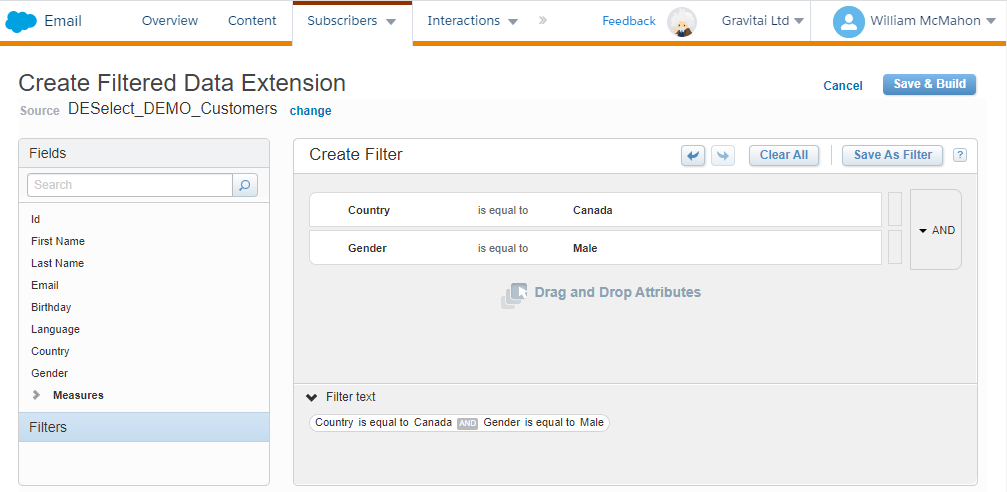
Basic SQL Query Functionality: SFMC provides a basic interface to run SQL queries for those familiar with SQL. This feature is handy for complex data manipulations extending beyond simple filtering. Marketers can extract, transform, and load (ETL) their data to suit specific campaign needs
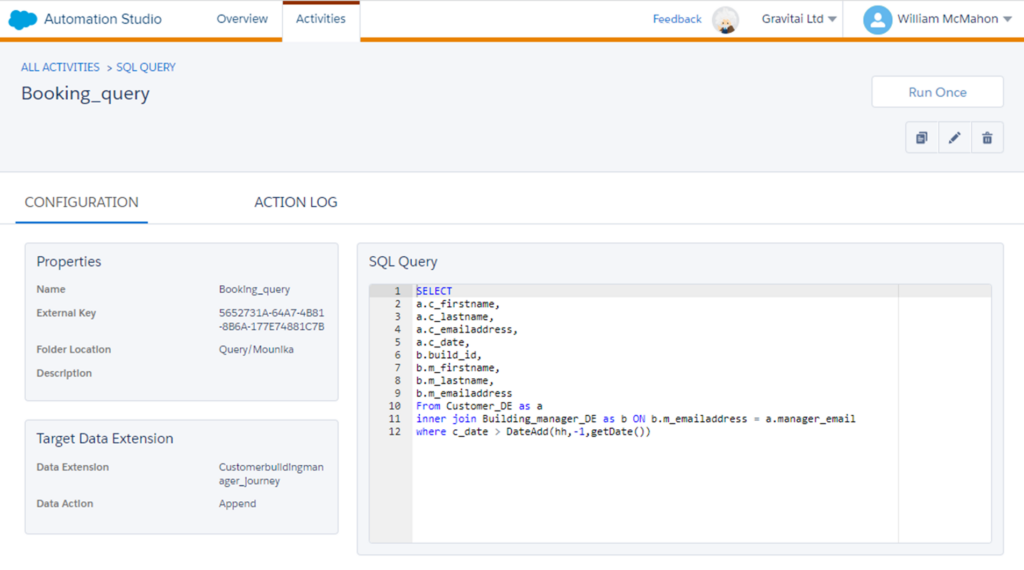
Automation Studio: This is where the magic of automation happens. Marketers can set up workflows to automate tasks like data imports, data filtering, and even running SQL queries at scheduled intervals.
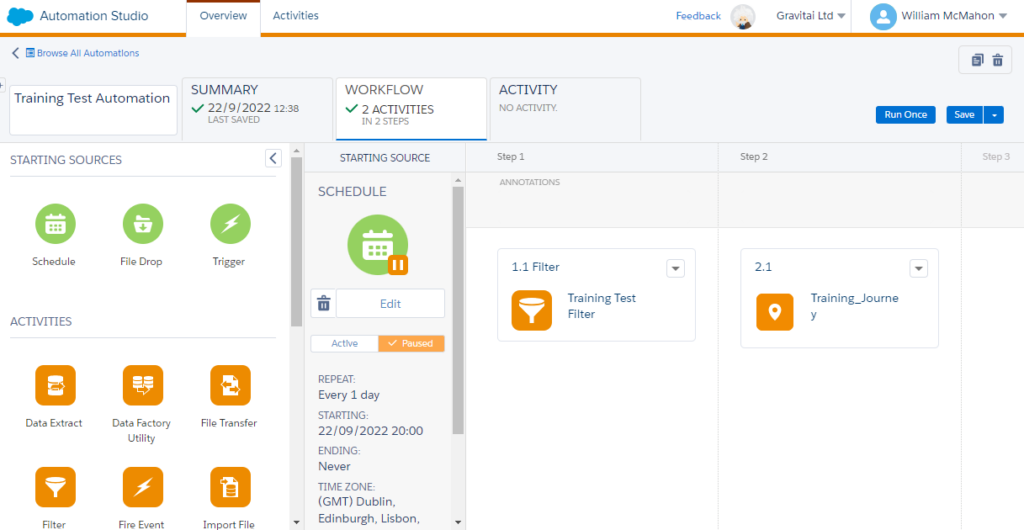
However, while these features are powerful, they come with their limitations:
- Single Data Extension Filtering: One significant limitation of Salesforce Marketing Cloud’s native capabilities is the restriction to filter within a single data extension at a time. Combining or comparing data across multiple data extensions is a challenge for the native tools, particularly when trying to gain a comprehensive view of customer interactions across different data sources.
- Performance of Filters: Filtering data within large data extensions can be sluggish, leading to delays in campaign launches or data analysis tasks. For marketers working in real-time or with tight schedules, these delays can impact the effectiveness and timeliness of their campaigns.
- Limitations in Joining Data: Salesforce Marketing Cloud’s Data Extension Filters make it challenging to cross-join data extensions, hindering marketers from gaining a holistic view of their data.
- Complexity of Advanced Queries: While basic filtering and data manipulation are straightforward, creating advanced SQL queries requires a deeper understanding of the language, which can be a barrier for marketers without an SQL background.
- Lack of Real-time Result Viewing for SQL Queries: A significant constraint with Salesforce Marketing Cloud’s native SQL capabilities is the absence of real-time result previews. When an SQL query is executed, the output is directed and stored in a separate data extension instead of being immediately displayed for review. This fragmented approach can be cumbersome and time-consuming, particularly when iterative query adjustments are needed.
- Performance Issues: Running complex queries on large data extensions can lead to performance problems, including slow query execution or timeouts.
Given these limitations, there was a clear need in the digital marketing landscape for a solution that seamlessly combined user accessibility with sophisticated data manipulation. Enter Query Studio for Salesforce Marketing Cloud.
Query Studio: The Game-Changer
Query Studio isn’t just another tool in the marketer’s toolkit; it’s the linchpin that connects marketers to their data more intuitively and efficiently. Specifically crafted to address the challenges of real-time result viewing and multi-data extension filtering, Query Studio allows users to run SQL queries and instantly preview the results. This real-time feedback loop accelerates the data exploration, enabling marketers to make quicker, data-informed decisions.
Furthermore, Query Studio’s design inherently tackles the challenge of filtering across multiple data extensions, providing a more holistic view of customer data without cumbersome steps. By offering an environment that marries the simplicity of user-friendly interfaces with the power of advanced SQL capabilities, Query Studio is the beacon for those looking to elevate their data-driven marketing strategies.
Key Features & Benefits: Unveiling Query Studio’s Power
As we explore the world of Query Studio, it’s clear that this tool redefines how we engage with and comprehend our data within Salesforce Marketing Cloud. Let’s take a closer look at the essential features that make Query Studio an invaluable asset for tech-savvy marketers:
Interactive Querying: Gone are the days of navigating SQL queries in the dark. Query Studio empowers you to execute SQL commands and instantly witness the results. This real-time feedback accelerates your data exploration and cultivates a more intuitive grasp of your data manipulations.
Data Preview: Have you ever made a change and immediately wished you hadn’t? Query Studio’s data preview feature ensures you remain in control. Before committing to any alterations, you can preview the data, guaranteeing that your modifications align with your intentions. This not only reduces errors but also elevates data integrity.
Data Export: Data isn’t bound to a single platform. Query Studio simplifies data export, whether you want to share insights with a colleague or conduct further analysis using another tool. You can effortlessly export your results with just a few clicks, facilitating seamless cross-platform data utilization.
Syntax Highlighting: SQL, while powerful, can be intricate. Query Studio’s syntax highlighting feature enhances the readability of your SQL code by distinguishing commands, variables, and values using color codes. This makes the code easier to read and aids in swiftly identifying errors, ensuring smooth query execution.
Validation Tests: One of Query Studio’s standout features is its built-in validation tests. Before running a query, the platform conducts a series of checks to ensure the integrity and correctness of your SQL code. This proactive measure identifies potential errors or inconsistencies, enabling you to address them before execution. Not only does this save time by preventing erroneous outputs, but it also instills confidence, knowing that your queries are meticulously vetted for accuracy. In a realm where precision reigns supreme, this validation feature is a game-changer, ensuring your data manipulations are effective and error-free.
Reusable Templates: Efficiency takes center stage. Recognizing that many SQL queries are recurrent, Query Studio offers a feature to save frequently used queries as templates. This means you don’t have to rewrite or reconfigure a query you’ve employed before. Load the template, make the necessary adjustments, and you’re ready to roll, conserving time and effort.
Unlocking the Potential of Your Data
Data takes on diverse forms and structures in the vast ecosystem of Salesforce Marketing Cloud. At its core are Data Extensions akin to tables in traditional databases. They neatly store rows of data with defined columns, enabling marketers to segment and target their audience based on various attributes. However, the data landscape within Salesforce Marketing Cloud is more intricate than these extensions alone.
An often-underestimated gem lies in Data Views, which are system-generated, read-only tables offering a glimpse into the historical tracking data of your account. These tables capture crucial metrics such as email sends, opens, clicks, bounces, etc. Essentially, they unveil the backstage of subscriber engagement, enabling marketers to glean insights into past interactions and behaviors.
With Query Studio, marketers can seamlessly interact with Data Extensions and Views. This dual capability creates more comprehensive data exploration:
- Interacting with Data Extensions: When you launch a query in Query Studio, you’re instructing the platform to retrieve or modify data from these extensions. Moreover, leveraging the power of SQL, you can seamlessly join multiple data extensions, filter records, or even craft new calculated fields, enriching your data landscape and providing more nuanced insights for your campaigns.
- Tapping into Data Views: Query Studio’s ability to query Data Views opens up a world of analytical possibilities. Marketers can analyze historical engagement trends, segment subscribers based on past interactions, and forecast future behaviors. Marketers curate more informed and impactful campaigns by blending insights from Data Views with current data from Data Extensions.
In essence, Query Studio’s versatility in handling both Data Extensions and Data Views ensures that marketers attain a 360-degree view of their data, paving the way for more profound insights and data-driven decision-making.
The Foundation: Understanding SQL
Before delving into the practical applications and intricacies of SQL within Query Studio, let’s embark on a journey to grasp the fundamentals of SQL, or Structured Query Language.
What is SQL?
At its essence, SQL serves as a language that facilitates communication with databases. Think of it as the bridge connecting human queries with data-driven responses. Whether you seek to retrieve specific data, update values, or delete records, SQL equips you with the tools to achieve these tasks.
Basic SQL Operations:
- SELECT: This command retrieves data from a database. For instance, to view all records from a table named ‘Subscribers,’ you’d use: SELECT * FROM Subscribers;
- INSERT: It permits the addition of new records to a table. For instance, to add a new subscriber, you might use: INSERT INTO Subscribers (FirstName, LastName) VALUES (‘John’, ‘Doe’);
- UPDATE: This command modifies existing records. If you wish to change John Doe’s last name to ‘Smith,’ you’d use: UPDATE Subscribers SET LastName = ‘Smith’ WHERE FirstName = ‘John’;
- DELETE: It removes records from a table. To remove John Smith from ‘Subscribers,’ you’d execute: DELETE FROM Subscribers WHERE FirstName = ‘John’ AND LastName = ‘Smith’;
Understanding these foundational SQL operations lays the groundwork for harnessing the full potential of Query Studio within Salesforce Marketing Cloud.
Delving into SQL Joins:
SQL Joins are pivotal in merging data from multiple tables (or data extensions) based on related columns. They are essential tools in SQL, enabling you to create comprehensive datasets from fragmented information.
Visual Representation
SQL Query
Description


Select <Field List>
FROM DataExtensionA A
LEFT JOIN DataExtensionB B
ON A.Key = B.Key
Select <Field List>
FROM DataExtensionA A
LEFT JOIN DataExtensionB B
ON A.Key = B.Key
WHERE B.Key IS NULL
LEFT JOIN (or LEFT OUTER JOIN): These two options return all records from the left table, and the matched records from the right table. Unmatched records from the right table will appear as NULL.

Select <Field List>
FROM DataExtensionA A
INNER JOIN DataExtensionB B
ON A.Key = B.Key
INNER JOIN: Fetches rows from both tables that satisfy the given condition. It focuses on the commonality between two tables.


Select <Field List>
FROM DataExtensionA A
FULL OUTER JOIN DataExtensionB B
ON A.Key = B.Key
Select <Field List>
FROM DataExtensionA A
FULL OUTER JOIN DataExtensionB B
ON A.Key = B.Key
WHERE A.Key IS NULL OR B.Key IS NULL
FULL JOIN (or FULL OUTER JOIN): Combines the results of both LEFT and RIGHT joins. It returns all records when there’s a match in either the left or the right table.


Select <Field List>
FROM DataExtensionA A
RIGHT JOIN DataExtensionB B
ON A.Key = B.Key
Select <Field List>
FROM DataExtensionA A
RIGHT JOIN DataExtensionB B
ON A.Key = B.Key
WHERE A.Key IS NULL
RIGHT JOIN (or RIGHT OUTER JOIN): Opposite of the LEFT JOIN. It returns all records from the right table, and the matched records from the left table.
As we venture deeper into SQL, it’s crucial to recognise that Salesforce Marketing Cloud’s Query Studio introduces its own unique twists. While the fundamental principles of SQL remain intact, Query Studio deviates slightly from traditional SQL conventions. Here, what we traditionally regard as ‘databases’ are represented as data extensions or data views. Furthermore, operations like ‘INSERT,’ ‘UPDATE,’ and ‘DELETE,’ which are standard in traditional SQL, take on a different configuration within Query Studio.
When you save your SQL query within Salesforce Marketing Cloud, these operations are configured as settings. Additionally, SQL queries in Query Studio do not terminate with ‘;’ as in traditional SQL. Certain advanced commands/functions may also have restrictions but worry not – the validation messages in Query Studio are usually informative, guiding you through these differences.
As we delve further into this journey, you’ll become well-versed in navigating these distinctions, ensuring you can fully leverage Query Studio for your data-driven marketing initiatives.
Data Extensions: The Backbone of Your Data Structure
Data extension structures are pivotal in shaping how you interact with your audience data within Salesforce Marketing Cloud. While each organization may have unique data configurations, a typical data hierarchy emerges, which many Salesforce Marketing Cloud clients adopt. This hierarchy streamlines data management and lays the foundation for intricate data manipulations using tools like Query Studio.
Let’s explore this conceptual data hierarchy:
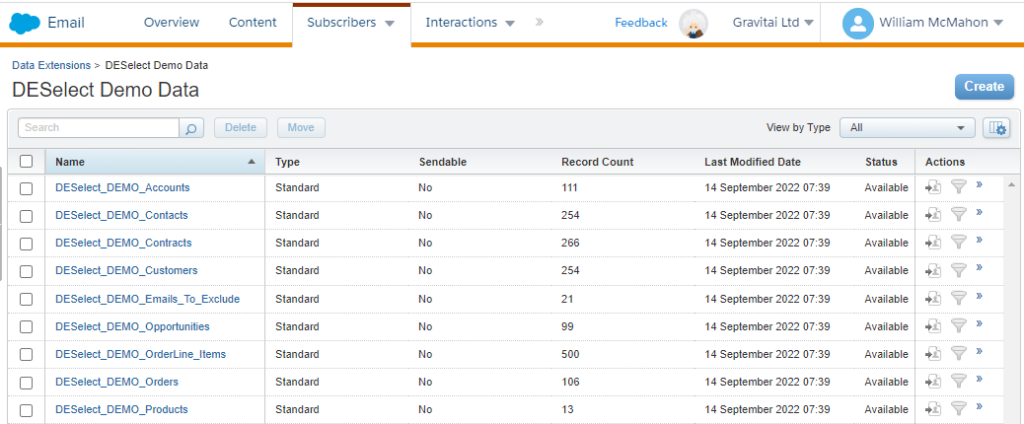
- In Salesforce Marketing Cloud, our Data Hierarchy is stored under Data Extensions, and a visual representation of the interconnectivity of each data extension can be visualized below.
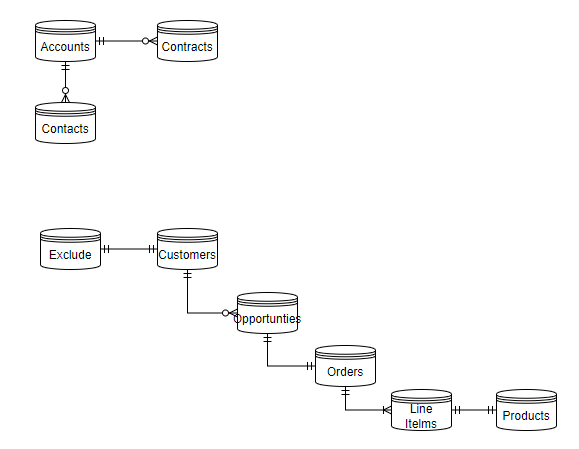
- Accounts: These form the backbone of any business data structure, representing the companies or entities you engage with, including partners, competitors, customers, or other stakeholders.
- Contacts: Individuals associated with these accounts, such as employees, representatives, or any person linked to an account.
- Contracts: Legal agreements between your company and these accounts detailing the terms of your business relationship.
- Customers: These are the individuals or entities purchasing your products or services, essentially the lifeblood of any business.
- Emails To Exclude: This is a critical data extension, particularly in email marketing, containing a list of contacts who have opted out or should not receive certain communications.
- Opportunities: These represent potential sales or deals, tracking the possibility of a contract or sale to a customer.
- Orders: Confirmed customer requests for products or services, signifying a successful opportunity conversion.
- Order Line Items: These provide granular details of each order, breaking down the products or services requested.
- Products: The items or services offered to customers, forming the core of what your business sells or provides.
While we won’t delve into the intricate configurations of each data extension and its fields, it’s essential to understand each entity’s relationship between data extensions. This understanding serves as a blueprint for how we join data and, more importantly, ensure we obtain the correct selection results.
With this understanding in place, we’re poised to demonstrate the capabilities of Query Studio. Using this typical data hierarchy, we’ll craft SQL queries to join, query, and build audience segments, showcasing the tool’s prowess in real-world scenarios.
Data Hygiene: Fuelling Your Marketing Machine
Just as a well-oiled machine operates at its best with clean fuel, your marketing strategies thrive on clean, accurate data. This is where the critical concept of data hygiene comes into play.
Understanding Data Hygiene: Data hygiene is the meticulous process of ensuring that a dataset is accurate but also consistent and usable. It involves identifying and rectifying errors, inconsistencies, and inaccuracies in data. In marketing, good data hygiene is akin to the compass guiding your campaigns to reach the right audience at the right time and with the right message.
The GDPR Perspective: Introducing regulations like the General Data Protection Regulation (GDPR) has elevated data hygiene from a best practice to a legal obligation. GDPR mandates that organizations handle personal data carefully, emphasizing accuracy and relevance. Regular data cleansing is not just advisable; it’s essential to remain compliant, avoid substantial fines, and, most importantly, maintain the trust of your customers.
Query Studio: Your Data Cleansing Ally
Salesforce Marketing Cloud’s Query Studio isn’t just a querying tool; it’s a potent instrument for data hygiene. Thanks to its robust SQL capabilities, you can:
- Identify and eradicate duplicate records
- Correct or transform data values
- Standardize data formats
- Validate and correct data types
For instance, if an email field contains values that don’t resemble email addresses or a date field has entries in multiple formats, these inconsistencies can be swiftly identified and rectified using SQL queries in Query Studio
The Crucial Role of Correct Data Types
Data isn’t merely about values; it’s about the context these values represent. An incorrect data type can distort this context. For instance, treating a numeric value as a text string can hinder mathematical operations. Ensuring that each field in your dataset has the correct data type is paramount for accurate analysis and operations.
In the world of data, there’s a fundamental principle: “The quality of your input determines the quality of your output.” This idea succinctly emphasises that the results you obtain are intricately linked to the quality of the data you start with. If your data is filled with mistakes, variations, or inaccuracies, these issues will ripple through all your marketing endeavours, potentially undermining their impact.
Use Case #1: COUNTing Records
In many scenarios, marketers require a quick overview of the volume of records within a specific data extension or the expected result from a SQL query. This snapshot allows you to gauge the size of a potential audience or data selection without running an entire data selection. Counting records provides vital insights into the data extension’s size and possible applications.
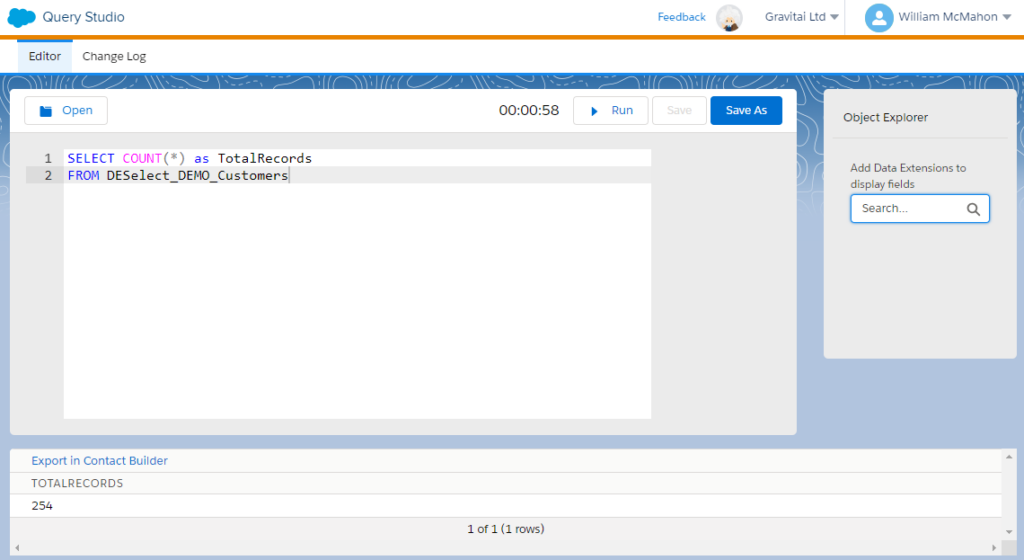
This SQL query returns a single value, ‘TotalRecords,’ representing the total number of records within the ‘Customers’ data extension. The same logic can be applied to any other data extension within your hierarchy to obtain a count of its records. It’s worth noting the aesthetics of Query Studio’s syntax colors and line numbers, which prove invaluable when validation errors occur, helping you quickly spot mistakes and typos.
Upon clicking the ‘Run’ button, Query Studio enters a processing queue on the Salesforce Marketing Cloud server. The processing time depends on various factors, including data volume and the time of day. Peak times may result in longer processing waits.
Use Case #2: WHERE Statement – Filtering our Data
In the world of data, precision is vital. Whether you’re homing in on a specific audience segment, dissecting product sales, or tracking account activities, the ability to filter data is indispensable. SQL’s WHERE statement is your precision instrument, enabling you to set conditions that filter and retrieve precisely the data you need from a data extension.
Building upon our previous example of counting records, let’s now put the WHERE statement to work by counting how many records exist in the ‘DESelect_DEMO_Customers’ data extension where the ‘Country’ field is ‘Canada’.
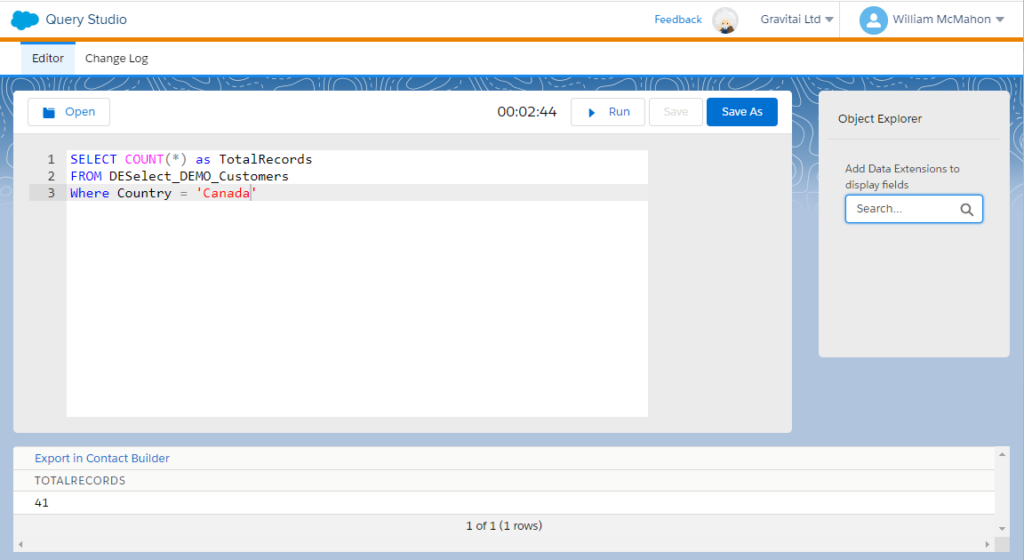
The WHERE clause, in SQL parlance, acts as the gatekeeper, allowing only records that meet specified conditions to pass through. These conditions can range from straightforward, like gathering all customers from a particular country, to more intricate, involving multiple criteria, such as country and gender.
As we delve deeper into SQL filtering, you’ll inevitably encounter scenarios where multiple conditions must be satisfied simultaneously, or any of several conditions will suffice. This is where the versatile AND and OR operators come into play:
AND Operator: This operator enters the scene when you need records that meet more than one condition, and all of these conditions must be true. For instance, if you’re in search of customers from Canada who are also male, both conditions must hold.

OR Operator: Conversely, the OR operator steps in when you filter based on multiple conditions, and it’s sufficient for any of these conditions to be true. For example, if you’re seeking customers from Canada or Ireland, satisfying either condition will fetch the record.

But a word of caution is in order here. Combining these operators requires deliberate care. Misusing or misordering them can lead to unintended results. For instance, without careful bracketing or logical sequencing, you might unwittingly retrieve records that don’t match your intended criteria.
For instance, imagine you’re trying to gather contacts from New York with an ‘Active’ status or contacts from Los Angeles, irrespective of their status. A poorly constructed query could net active contacts from cities other than New York, leading to data inaccuracies.
As a challenge and a learning opportunity, try to construct what the SQL query for this scenario would look like before reading on. If you’re grappling with the technical aspects of SQL, feel free. Keep your commitment to learning, as practice makes perfect. Stay tuned as we’ll discuss alternative tools that can simplify your data operations without a need for deep SQL knowledge.
The correct answer is:

In this query, the thoughtful use of parentheses ensures that conditions are evaluated in the precise order needed to yield the desired results.
While the AND and OR operators are potent tools for refining your data queries, they should be handled with care. Proper structuring and a clear grasp of the logic you wish to implement are vital to ensure the accuracy of your results.
Use Case #3: FIELDS and Output
As we venture further into the world of SQL, it’s essential to grasp that numbers alone sometimes don’t paint the complete picture. The actual data within fields is often the key to understanding your audience or your business. Visualizing the data fields can unveil profound insights, whether you’re delving into customer demographics, scrutinizing product details, or dissecting account activities.
In Query Studio, making these data fields visible is a straightforward process. You can achieve this by adding the names of the data extension fields you wish to appear in the SELECT statement of your SQL query.

The selected results are then displayed in the output window, with records typically presented ten at a time for easier readability.
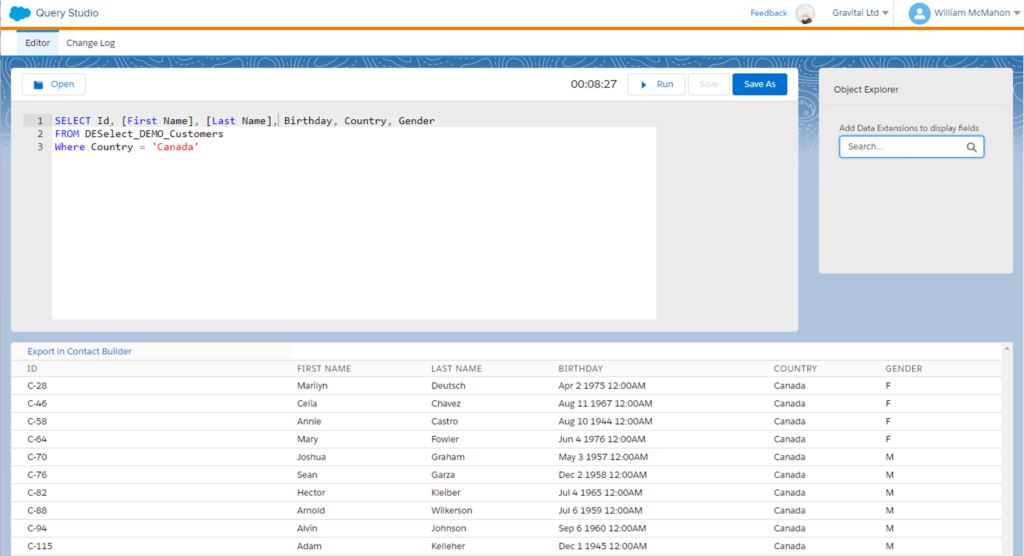
However, in Salesforce Marketing Cloud, field names sometimes contain spaces, reserved words, or special characters. While these naming conventions might be more human-readable, they can pose challenges during SQL querying. Additionally, there are situations where you might need to customize or transform the output, like combining fields or renaming them for clarity.

As shown earlier, dealing with field names containing spaces or special characters in SQL requires enclosing them in square brackets [ ] to ensure they’re recognized correctly. Furthermore, SQL provides the ability to rename (or alias) the output fields using the AS keyword. This is handy when you want the output to have a different name than the source field.
When saving the results of a query to a destination data extension in Salesforce Marketing Cloud, the destination data extension must contain fields with the same names specified in the query output. Mismatches between the output and destination fields can lead to errors or failed query executions.
You can also use SQL’s AS term when merging fields from your source data extension into a single output field. For example, you might want to concatenate [First Name] and [Last Name] into a single field called [Full Name]. The SQL query to achieve this is relatively straightforward.

This query takes the First Name and Last Name fields, combines them with a space in between, and outputs the result as Full Name.
Understanding these nuances in a platform like Salesforce Marketing Cloud’s Query Studio can significantly enhance your data querying capabilities, allowing for more tailored and precise outputs that suit your needs.
Use Case #4: SAVE your Query and Results
Now that you’ve delved into crafting SQL queries in Query Studio, it’s time to explore how to save your queries. This step is essential if you intend to reuse your queries in Automation Studio for routine audience updates.
Saving your query is straightforward. Just click on the ‘Save As’ button and give your query a meaningful name. However, there are a couple of critical considerations when doing this.
First, you must select a destination data extension where you want to store the results. It’s essential to ensure that this data extension contains the fields or data schema you’ve specified in your SELECT statement. This alignment between your query’s output and the destination data extension is crucial for smooth execution.

While there’s an ‘Export in Contact Builder’ feature that theoretically should create the data extension for you, it’s worth noting that it can sometimes be finicky. As a best practice, it’s often more reliable to manually create the data extension schema, ensuring it matches your query’s output.
After you’ve saved your query, you’ll also need to decide on the Data Action to take. This is a pivotal step that determines how the results of your query will interact with existing data. There are three distinct Data Actions to choose from: Overwrite, Update, and Append. Each action serves a specific purpose and can significantly impact your data.
Overwrite:
- Purpose: This action replaces the entire content of a target data extension with the results of your SQL query.
- Use Case: Consider a scenario where you have a monthly list of active subscribers, and at the beginning of each month, you want to refresh this list based on new activity. To achieve this, you can utilize the ‘Overwrite’ action. This action essentially swaps out the old data with the new data, guaranteeing that your list stays up-to-date and precise.
Update:
- Purpose: Instead of replacing all the data, the ‘Update’ action modifies only specific records in the target data extension based on the results of your SQL query.
- Use Case: Suppose you have a data extension of customers, and you’ve recently run a campaign where some customers updated their contact information. Instead of replacing the entire data extension, you’d use the ‘Update’ action to modify only those records with new information, leaving the rest untouched.
Append:
- Purpose: This action adds the results of your SQL query to the end of an existing data extension without altering the current records.
- Use Case: Imagine you have a data extension of newsletter subscribers, and after a recent event, you’ve gathered a new list of interested participants. Using the ‘Append’ action, you can add these new subscribers to your existing list without affecting the original subscribers.
Choosing the right Data Action is pivotal. An incorrect choice can lead to data loss, duplication, or inaccuracies. For instance, using ‘Overwrite’ when ‘Append’ was intended could erase valuable data. Conversely, appending data without checking for duplicates might lead to redundancy.
So, when saving your query and specifying the Data Action, consider the nature of your data and the intended outcome carefully. This decision ensures that your data remains accurate and aligns with your marketing objectives.
Use Case #5: DATEDIFF – Calculating time intervals between dates, plus Birthdays/Anniversaries
Whether you’re deciphering the time lapse between a customer’s initial interaction and their purchase, scrutinizing the timing of email dispatches, or commemorating your customer’s birthdays, the ability to compute date differences holds immense value. This is precisely where the DateDiff function in SQL steps in.
The DateDiff function is a potent tool for computing the disparity between two dates and presenting the outcome in the units you designate, such as days, months, or years. It proves incredibly useful when you aim to glean insights into customer behaviors or make data-driven choices grounded in time intervals.
However, there are some considerations to bear in mind. Firstly, the DateDiff function operates with ‘Date/Time’ fields, so maintaining consistent date formatting is imperative. Additionally, it necessitates three parameters in the correct sequence: the unit (e.g., day, month, or year), the commencement date, and the culmination date.
Let’s delve into an illustration. Picture this: you wish to ascertain how many days transpire between the placement of an order and its delivery. By computing the variance between the ‘Order Date’ and the ‘Delivery Date,’ you can acquire this data. This calculation serves to enlighten you on delivery durations and empowers you to apprise customers about any potential delays.
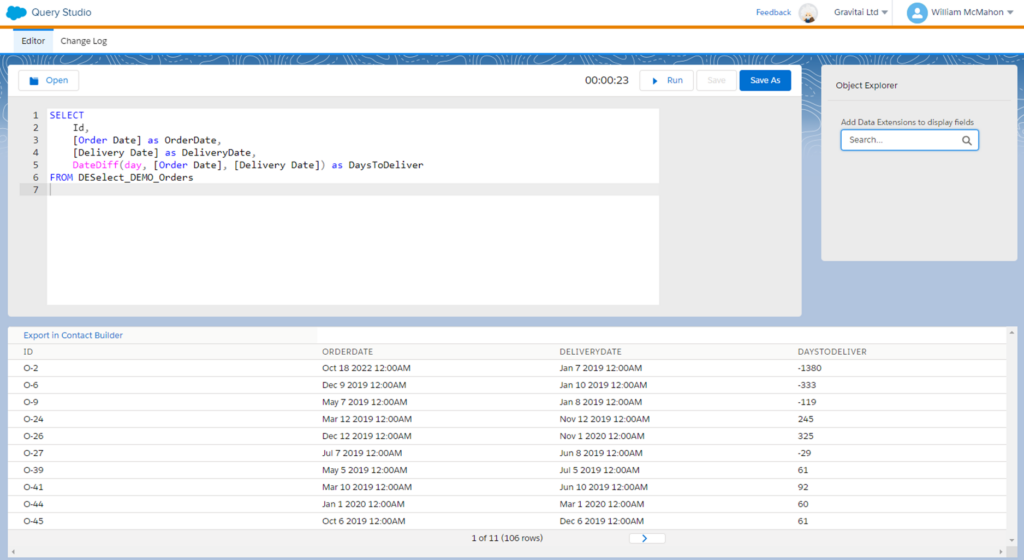
Now, let’s tackle a fun and practical scenario. How about identifying customers who are celebrating their birthday today? Sending personalized birthday greetings or offers is a fantastic way to engage with your customers and build loyalty. But here’s the twist – birthdays happen every year, and you don’t want to congratulate someone multiple times in a year!
To do this, you’ll need to leverage the DateDiff function creatively. Instead of comparing the birthday field directly to today’s date, which includes the year, you’ll calculate the difference in years between the birthday and today. If this difference, when added to the birthday, equals today’s date (excluding the year), you’ve got a match.
In simpler terms, this condition helps you identify people who are celebrating their birthday today, regardless of which year they were born. It’s a smart way to handle anniversaries like birthdays.

You’ve got some handy date functions at your disposal in SQL. For instance, there’s GetDate(), which fetches the current date and time based on your system’s clock. It’s perfect for when you need the current timestamp.
In substitution to GetDate, there’s GetUTCDate(), and this one is particularly valuable for global applications. It provides the date and time in Coordinated Universal Time (UTC), which remains consistent regardless of time zones or daylight-saving changes. This is essential when you want to work with a standardized time reference across different regions.
So, you see, SQL equips you with the tools to work with time and dates effectively, no matter where your data or users are located. Functions like YEAR(), MONTH(), and DAY() are also handy when you need to extract specific date components, like the year or month.
As you can see, we are starting to expand further our knowledge of SQL with some additional functions:
- GetDate() : This function returns the current date and time based on the system’s clock. When executed, this will return the current date and time, including hours, minutes, seconds, and milliseconds. It’s commonly used when you need to compare a date in your data to the current date and time.
- GetUTCDate() : Whilst not used in our Query above, it’s an important one to call out. Unlike GETDATE(), which returns the current date and time based on the system’s local settings, GETUTCDATE() provides a consistent time reference that isn’t influenced by time zones or daylight-saving changes. Therefore, we can use GetUTCDate() in substitution to GetDate() as it returns the current date and time based on the Coordinated Universal Time (UTC), which is essentially the world’s standard time reference.
- YEAR(), MONTH(), DAY() : These individual functions are particularly useful when you want to isolate or compare just a portion of a date e.g. Year, Month, Day.
As we’ve learned earlier, the WHERE function can be used be used to filter or match the results, and within the WHERE criteria we can also use DateDiff and other SQL functions.
In our example, The WHERE condition is checking if the sum of the difference in years between the Birthday and the current date (DateDiff(year, Birthday, GETDATE())) and the year of the Birthday (YEAR(Birthday)) is equal to the current year (YEAR(GETDATE())).
Using our example:
- Difference in years: 33
- Year of Birthday: 1990
- Sum: 33 + 1990 = 2023
- Current year: 2023
Likewise, the WHERE condition checks if the day and month of the Birthday field match today’s day and month, ensuring that only those celebrating their birthday today are retrieved.
The purpose of this condition is to identify records where the day and month of the Birthday match the current day and month, but without considering the year. This is a clever way to identify anniversaries, like birthdays, which occur on the same day and month every year but have a different year.
Let’s blow your mind even further – say you want to calculate the age of the customer and store it in the data extension. With the knowledge you’ve so far learned, how do you think you’d go about this?
It’s pretty simple, as you already have all of the code above, and you should be familiar with the AS function for renaming fields – remember?

These date functions are fundamental tools in SQL, especially when working with date-time data. They allow for precise extraction and manipulation of specific components of dates, enabling detailed analyses and comparisons. In Salesforce Marketing Cloud’s Query Studio, understanding and effectively using these functions can greatly enhance data querying capabilities, allowing for more tailored outputs and insights.
When combined, as seen in the birthday example, these functions can be used to craft complex conditions and criteria, ensuring that you can extract exactly the data you need, no matter how specific or nuanced your requirements might be.
A Quick Use Case Summary
Our journey into the world of SQL and Salesforce Marketing Cloud’s Query Studio has been nothing short of fascinating. We’ve touched the surface of its vast potential through the examples and use cases explored here.
While these scenarios provide a solid foundation for your data-driven marketing endeavors, SQL, and Query Studio offer an ocean of possibilities. The depth and versatility of SQL, combined with the power of Query Studio, are limitless.
Limitations of Query Studio
While Salesforce Marketing Cloud’s Query Studio offers valuable features for marketers, it’s crucial to understand its limitations to work effectively within its boundaries or explore alternative solutions when necessary. Let’s take a closer look at some important limitations to keep in mind:
- Query Length:
- Constraint: Queries in Query Studio have a character limit. Extremely lengthy or complex queries might not run or even fit within the tool.
- Implication: Query writers need to be concise and efficient in their query construction. If a query is too long, it may need to be broken down into multiple smaller queries or optimized for brevity. Here, it is necessary to know SQL well enough that you can make any necessary query, no matter how complex, in as few strings as possible.
- Execution Time:
- Constraint: There’s a maximum time limit (typically 30 minutes) for how long a query can run in Query Studio. If a query exceeds this, it will time out and fail to execute.
- Implication: This limitation can be challenging when working with large datasets or performing complex data manipulations. Users may need to optimize their queries for performance, break them down into more minor queries, or consider running them during off-peak times.
- Complex Joins:
- Constraint: While SQL allows for joining multiple tables or data extensions, doing so with large data extensions in Query Studio can be resource-intensive and slow.
- Implication: Joining multiple large data extensions can increase execution time (risking timeouts) and consume more resources, potentially affecting other processes. Users should strategically plan joins, ensuring they are necessary and optimized for performance.
- Error Feedback:
- Constraint: Query Studio might not always provide detailed error messages, making it challenging to pinpoint issues in a query.
- Implication: Debugging and troubleshooting can become time-consuming. Users may need to rely on their SQL knowledge or seek external resources to understand and resolve errors.
- Data Volume:
- Constraint: Query Studio is primarily designed for querying, not bulk data processing. It might not be the most efficient tool when dealing with millions of records.
- Implication: Users should consider other tools or platforms within Salesforce Marketing Cloud for extensive data processing tasks or break down tasks into more manageable chunks.
- Technical Language and Complexity:
- Constraint: SQL is a Programming Language, and Query Studio is just an SQL Query execution tool. Users require a steep learning curve to upskill on SQL, functions, and practices.
- Implication: The technicalities can become overwhelming for many non-developers, and mistakes can easily be made (e.g. selecting the wrong audiences).
Understanding these limitations is crucial for the efficient use of Query Studio. In some cases, users may find that more advanced tasks or working with extensive datasets are better suited for other tools or platforms within Salesforce Marketing Cloud or external data processing solutions.
Simplifying with DESelect
DESelect provides a valuable solution for marketers looking to simplify the process of data querying and manipulation in Salesforce Marketing Cloud. It bridges the gap between traditional marketing practices and the complexities of SQL, making data-driven marketing more accessible and efficient.
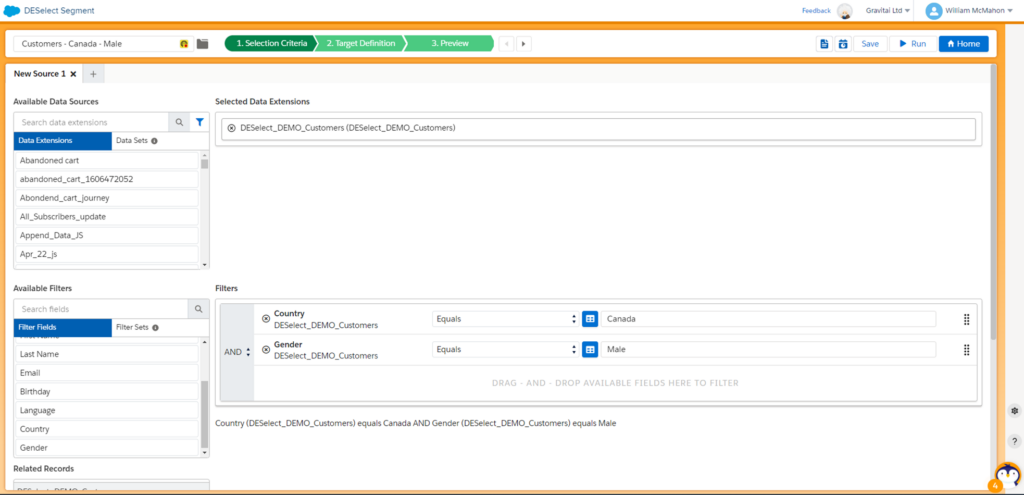
Circling back to the benefits of Query Studio, DESelect has similar functions.
Query Studio Benefit: Interactive Querying
DESelect Segment’s drag-and-drop interface is designed for marketers, allowing them to visually build complex queries without the need for extensive SQL knowledge. There’s SQL under the hood driving each query, but this intuitive approach makes it easier for marketers to engage with data and create targeted segments.
Benefit: Data Preview
Review data before submitting a query, previewing elements such as how many records your query will return, a detailed view of the created data extension, and any errors that would hinder results.
Benefit: Data Export
DESelect seamlessly integrates with Salesforce Marketing Cloud, ensuring smooth data flow between the platforms. This integration streamlines workflows and enhances productivity for marketers.
Benefit: Validation Tests
DESelect optimizes queries in the background, ensuring they run efficiently. This reduces the risk of query timeouts and allows marketers to focus on deriving insights from their data rather than troubleshooting performance issues.
Benefit: Reusable Templates
DESelect admins use segmentation templates for commonly run campaigns, in effect saving users’ time and preventing mistakes. Once you have templates in place, you can reuse them for similar segments in the future.
Here are some key ways that DESelect Segment improves on Query Studio:
Advantage: The Scope of Advanced Segmentation
DESelect Segment offers powerful segmentation features that are both user-friendly and robust. Marketers can create intricate data segments for various purposes, such as targeted campaigns, A/B testing, and audience analysis, leading to more personalized and effective marketing efforts.
Advantage: Guided Workflows
DESelect provides guided workflows that walk users through the data querying and manipulation process step by step. This guidance reduces errors and enhances efficiency, making it suitable for users of all skill levels.
Overall, DESelect empowers marketers to make the most of their data within Salesforce Marketing Cloud, whether they are SQL experts looking for optimized performance or newcomers seeking a more user-friendly interface. It’s a valuable tool for data-driven marketing that makes complex tasks more accessible and efficient.
How to Get Started with DESelect
Beginning your journey with DESelect is a straightforward plug-and-play process designed to quickly get you started harnessing the power of your data within Salesforce Marketing Cloud.
DESelect works with a list of certified implementation partners, to provide teams new to Marketing Cloud with top-tier solutions and expertise within the Salesforce ecosystem.
Learn how to find the best solution for your segmentation needs.

William McMahon
CEO & Founder at Gravitai, William has over 15 years experience in the CRM world as both a top UK Salesforce Partner and Ex-ExactTarget Principal Solutions Architect.
Table of Contents
An Overview of AMPscript in Salesforce Marketing Cloud
Are you looking to elevate your email marketing campaigns to new heights of personalization and engagement? AMPscript is a proprietary scripting language that empowers marketers to create one-to-one, personalized communications across various digital channels such as emails, landing pages, SMS, and push messages.
In this blog, we’ll dive into the benefits of using AMPscript in Marketing Cloud, provide you with practical examples, and guide you on how to get started with this powerful tool.
The Magic of Marketing Cloud AMPscript
AMPscript opens up a world of possibilities for digital marketers. Here are some of the key advantages:
Personalization: AMPscript allows you to personalize your emails using subscriber or contact data. Imagine addressing your recipients by their first name or tailoring content based on their preferences – that’s the kind of personalization AMPscript can bring to your campaigns.
Dynamic Content: Create dynamic and highly engaging emails using conditional logic. With AMPscript, you can craft emails that change based on specific conditions. This means you can send tailored content to different segments of your audience without creating multiple versions of the same email.
Data Cleanup and Formatting: AMPscript isn’t just about personalization, it can also help you clean and format your data. Ensuring that your data is clean and structured correctly is essential for effective marketing.
Real-Time Information: Inject real-time information into your emails, such as the current date or time. This dynamic content can create a sense of urgency or relevance in your communications.
Tracking Impressions: Gain valuable insights into how recipients interact with your content, helping you refine your strategies and messaging.
But AMPscript’s capabilities extend beyond just personalizing emails. It can also modify Marketing Cloud content, such as text and images in email messages, and offers strings to pull information into content, email addresses, and other areas where dynamic values are required.
Examples of AMPscript Function in Action
Now, let’s see how to use AMPscript in Marketing Cloud with some practical examples:
Example 1: Basic Personalization
```html
%%[
var @firstName
set @firstName = [First Name]
]%%
Hi %%=v(@firstName)=%%,
We have some exciting news to share with you!
```
Copy
In this example, we’re pulling the subscriber’s first name from the data and using it to personalize the email greeting.
Example 2: Dynamic Content
```html
%%[
var @productImage
set @productImage = "default.jpg"
if @gender == "Male" then
set @productImage = "mens_shirt.jpg"
else
set @productImage = "womens_dress.jpg"
endif
]%%
Check out our latest collection:
<img decoding="async" src="data:image/svg+xml,%3Csvg%20xmlns='http://www.w3.org/2000/svg'%20width='0'%20height='0'%20viewBox='0%200%200%200'%3E%3C/svg%3E" alt="Latest Collection" class="perfmatters-lazy" data-src="https://%%=v(@productImage)=%%" /><noscript><img decoding="async" src="https://%%=v(@productImage)=%%" alt="Latest Collection"></noscript>
```
Copy
This example showcases dynamic content based on the subscriber’s gender. It dynamically changes the product image depending on the recipient’s gender.
Example 3: Tracking Links
```html
%%[
var @linkURL
set @linkURL = "https://www.example.com/campaign-link"
]%%
<a href="%%=RedirectTo(@linkURL)=%%">Click here to learn more</a>
```
Copy
In this example, AMPscript is used to create a tracked link. When recipients click the link, their interaction is recorded, providing valuable insights into campaign performance.
Getting Started with AMPscript in Marketing Cloud
Are you eager to start using AMPscript in your Marketing Cloud campaigns? Here’s a simple guide to get you started:
Learn the Basics: Begin with the fundamentals – syntax, functions, and capabilities. Salesforce Trailhead offers an excellent “Explore AMPscript” unit that covers the essentials, as does this introduction to AMPScript. It’s a great starting point for beginners.
Practice, Practice, Practice: Like any language, practice is key to mastering AMPscript. Start with simple examples and gradually work your way up to more complex scripts. Experimenting with real data in a sandbox environment can be incredibly valuable.
Leverage Resources: There are numerous resources available to help you on your AMPscript journey. Online forums and communities like Salesforce Stack Exchange can be invaluable for troubleshooting and learning from others.
Take a Course: Consider enrolling in a structured course or workshop dedicated to AMPscript. Many online platforms offer Salesforce Marketing Cloud courses that cover AMPscript in depth.
Stay Updated: The world of marketing and technology evolves rapidly. Keep up with the latest developments and best practices in AMPscript to ensure your skills remain relevant.
Test Thoroughly: Always test your AMPscript thoroughly before deploying it in a live campaign. Ensure that it behaves as expected and that it doesn’t produce errors or unwanted results.
Collaborate: Don’t hesitate to collaborate with your team members or seek help from the Salesforce Marketing Cloud community. Collaboration often leads to creative solutions and faster learning.
Conclusion
AMPscript is a game-changer for digital marketers. Its ability to personalize, automate, and enhance email marketing campaigns is unmatched. By learning and mastering AMPscript, you can take your marketing efforts to the next level, delivering highly tailored and engaging content to your audience.
So if you want to unlock the full potential of Salesforce Marketing Cloud and create more effective and engaging email campaigns, consider diving into the world of AMPscript. It’s a skill that can set you apart in the competitive field of digital marketing. Happy coding!
DESelect | Best Salesforce Marketing Cloud Solutions Blog | How to Write SQL: The Most Common Queries in SFMC
Structured Query Language (SQL) is a powerful programming language designed for managing data within relational databases. Similar to Excel, these databases organize information in tables, utilizing rows and columns to represent distinct data attributes and their relationships. SQL enables users to execute commands for storing, updating, removing, searching, and retrieving data, contributing to efficient database management.
Widely embraced across diverse applications, SQL is favored by data analysts and developers for its seamless integration with various programming languages, such as Java. Its user friendly nature, employing common English keywords, makes SQL accessible for learners and facilitates the creation of high-performance data processing applications.
For those who want to learn how to write SQL, we will review concepts specific to Marketing Cloud, the parts of a query, and applying these queries to common use cases.
RELATED: Script Activity – The underrated SFMC powerhouse
What is SQL used for in Salesforce Marketing Cloud?
In Salesforce Marketing Cloud, data extensions act like tables for storing and organizing data. They help structure information within the platform, allowing users to interact with and manipulate data in these extensions, in turn facilitating smooth integration into marketing efforts and analytics.
These extensions can store diverse data like customer details, preferences, and buyer behavior. SQL queries offer a robust way for marketers to efficiently extract, filter, and organize data within these extensions.
SQL Essential Tasks
Querying and Manipulating Data
Querying with SQL empowers marketers and administrators to pinpoint precise data among complex datasets and manipulate it, enabling users to transform and organize information to align with marketing goals. This capability not only streamlines analysis and operations but also ensures extracted data is structured effectively for activation. Ultimately, SQL in Salesforce Marketing Cloud goes beyond surface-level activity, unlocking a more powerful understanding of the customer base for data-driven marketing strategies.
Extracting and Filtering Data
SQL queries serve as a strategic tool, allowing users to sift through large volumes of information and focus solely on relevant data, simplifying the complex process of data extraction. The versatility of SQL is evident in its filtering capabilities, enabling marketers to pinpoint specific criteria crucial to their objectives.
Whether isolating data based on demographics, customer preferences, or behavioral patterns, SQL’s filtering functionality offers precise control that not only streamlines data extraction but also ensures the relevance of extracted information.
By leveraging SQL for data extraction and filtering in Salesforce Marketing Cloud, users optimize workflows, removing the need to manually hunt through data extensions. This targeted approach not only saves time but also ensures the extracted data is complete and accurate.
Organizing Data
SQL efficiently organizes data, offering robust tools beyond data retrieval. It establishes a coherent structure within databases, aligning with the analytical and reporting needs of marketers and administrators. This structured format ensures data is stored for effective analysis, fundamental for extracting meaningful insights and informed decision-making.
SQL enables the creation of easily navigable databases optimized for marketing strategies, laying the foundation for streamlined reporting. This organized data architecture enhances overall efficiency in data management, empowering users to make confident, data-driven decisions within Salesforce Marketing Cloud.
Segmentation of Audiences in Marketing Campaigns
In Salesforce Marketing Cloud, knowing how to write SQL queries plays is pivotal to marketers aiming to finely segment their customer base. SQL facilitates the strategic division of customers into distinct groups based on factors like demographics, preferences, and previous interactions.
SQL’s instrumental role in audience segmentation lies in its ability to analyze and interpret diverse datasets. Marketers craft SQL queries to pinpoint specific criteria, allowing for the creation of targeted segments that move beyond broad categorizations, offering a nuanced understanding of the customer base.
Segmentation criteria can vary widely, from geographic location to purchase history or engagement levels. With SQL’s capabilities, marketers gain the flexibility to define these criteria precisely, ensuring each segment is tailored to unique characteristics and behaviors.
Once audiences are segmented, marketers can deploy highly targeted and relevant marketing messages to each group. This level of personalization enhances campaign effectiveness, as messages resonate more directly with the specific interests and needs of each segment. Ultimately, SQL’s role in audience segmentation within Salesforce Marketing Cloud becomes a cornerstone for delivering impactful and tailored marketing experiences to diverse customer groups.
Facilitating Personalized Communication
SQL emerges as a powerful tool for marketers aiming to enhance their communication strategies. Through strategic use of SQL, marketers craft campaigns that go beyond generic messaging, focusing on targeted and personalized communication through specific audience criteria.
SQL’s ability to interact with customer attributes tailors campaigns to individual preferences. Marketers often use SQL queries to identify specific customer segments based on demographics, purchase history, or engagement patterns, allowing for the creation of campaigns that speak directly to the unique characteristics and interests of each segment. This personalized communication resonates more deeply with these audiences, establishing a meaningful connection more likely to drive conversions and purchases.
In essence, SQL’s role in Salesforce Marketing Cloud goes beyond data manipulation – it becomes a catalyst for elevating communication strategies, where each message is not just targeted but genuinely resonant with the diverse needs of the audience.
How to Write SQL: The Parts of a Query
In a SQL query used for Salesforce Marketing Cloud, several key components come together to retrieve, manipulate, or manage data. Here’s an overview of the essential parts:
SELECT Clause
Specifies the columns or fields to be retrieved from the database. For example, SELECT FirstName, LastName would retrieve data from these specific columns.
FROM Clause
Specifies the source table or data extension from which the data is being retrieved. For instance, FROM Contacts indicates that the data is sourced from the “Contacts” table or data extension.
WHERE Clause
Conditions that filter the rows of data returned by the query. It allows you to specify criteria, such as WHERE Age > 25, to retrieve only records where the age is greater than 25.
ORDER BY Clause
Determines the order in which the results are presented. For instance, ORDER BY CreatedDate DESC would arrange the results based on the “CreatedDate” column in descending order.
GROUP BY Clause
Groups rows that have the same values into summary rows, typically used with aggregate functions like COUNT, SUM, AVG. For example, GROUP BY Country groups data by the “Country” column.
HAVING Clause
Works in conjunction with GROUP BY and allows filtering on grouped results. It’s conditional, similar to the WHERE clause, but applied after the grouping has occurred. For example, when grouping by country, HAVING COUNT(CustomerID) > 5 will only include results where there are more than five results for a given country.
JOIN Clause
Specifies how tables or data extensions are related to each other. For instance, INNER JOIN Orders ON Customers.CustomerID = Orders.CustomerID would join the “Customers” and “Orders” tables based on the “CustomerID” column.
LIMIT/OFFSET Clause
Controls the number of rows returned and can be useful for paginating results. For example, LIMIT 10 OFFSET 20 would retrieve 10 rows, starting from the 21st row (offsetting the first 20).
Now you know how to write SQL. These components collectively form a query, allowing users to interact with and retrieve specific subsets of data from Salesforce Marketing Cloud databases or data extensions.
Essential SQL queries used in SFMC
Selecting Data
To retrieve specific columns from a Data Extension:
```sql
sql
SELECT FirstName, LastName, Email
FROM ContactDataExtension
```
Filtering Data
To filter data based on a specific condition:
```sql
sql
FROM PurchaseDataExtension
WHERE PurchaseAmount > 100
```
Joining Data
To combine data from two Data Extensions based on a common field:
```sql
sql
SELECT Orders.OrderID, Customers.CustomerName, Orders.OrderDate
FROM Orders
INNER JOIN Customers ON Orders.CustomerID = Customers.CustomerID
```
Grouping and Aggregating Data
To group data and calculate aggregates (e.g., total purchases per customer):
```sql
vbnet
SELECT CustomerID, COUNT(OrderID) AS TotalOrders, SUM(OrderAmount) AS TotalAmount
FROM OrderDataExtension
GROUP BY CustomerID
```
Ordering Data
To sort data in ascending or descending order:
```sql
sql
SELECT ProductName, Price
FROM ProductDataExtension
ORDER BY Price DESC
```
Limiting Results
To retrieve a specific number of rows:
```sql
sql
SELECT
FROM SubscriberDataExtension
LIMIT 10
```
Combining Filters
To apply multiple conditions using AND or OR:
```sql
sql
SELECT
FROM CustomerDataExtension
WHERE Age > 25 AND Country = 'USA'
```
SQL is essential for creating the right audience, but how do you personalize content to ensure you create the right message? Learn the basic overview of AMPscript.



